SolusVM Extended VPS For WHMCS
(→Common Problems) |
|||
| Line 5: | Line 5: | ||
{| | {| | ||
|style="padding: 10px 0px 10px 0px;"|'''SolusVM Extended VPS For WHMCS''' allows you to automatically provision virtual servers to your clients.<br /> | |style="padding: 10px 0px 10px 0px;"|'''SolusVM Extended VPS For WHMCS''' allows you to automatically provision virtual servers to your clients.<br /> | ||
| − | Owing to well-thought module configuration, you will be able to quickly and capably set up ready products in WHMCS and offer them to your customers.<br /> | + | Owing to a well-thought module configuration, you will be able to quickly and capably set up ready products in WHMCS and offer them to your customers.<br /> |
| − | + | The module lets your clients conveniently manage virtual servers from your own WHMCS client area. Everything in an easy and enjoyable way. | |
|} | |} | ||
<!-- fixed --> | <!-- fixed --> | ||
| Line 85: | Line 85: | ||
|} | |} | ||
{| | {| | ||
| − | |style="padding: 0px 0px 0px 30px;"|✔ SSH Console (OpenVZ & Xen | + | |style="padding: 0px 0px 0px 30px;"|✔ SSH Console (OpenVZ & Xen Virtualization) |
|} | |} | ||
{| | {| | ||
| − | |style="padding: 0px 0px 0px 30px;"|✔ VNC Console (KVM & Xen HVM | + | |style="padding: 0px 0px 0px 30px;"|✔ VNC Console (KVM & Xen HVM Virtualization) |
|} | |} | ||
{| | {| | ||
| Line 179: | Line 179: | ||
{| | {| | ||
|style="padding: 0px 0px 15px 15px;"|'''2. Upload and extract the module into the main WHMCS directory.'''<br /> | |style="padding: 0px 0px 15px 15px;"|'''2. Upload and extract the module into the main WHMCS directory.'''<br /> | ||
| − | Files in your WHMCS directory should look like | + | Files in your WHMCS directory should look like this. |
|} | |} | ||
{| | {| | ||
| Line 193: | Line 193: | ||
{| | {| | ||
|style="padding: 0px 0px 15px 15px;"|'''4. In order to configure your license key, you have to edit a previously renamed '' 'license.php' '' file.'''<br /> | |style="padding: 0px 0px 15px 15px;"|'''4. In order to configure your license key, you have to edit a previously renamed '' 'license.php' '' file.'''<br /> | ||
| − | Enter your license key between quotation marks as presented on the following screen. You can find your license key | + | Enter your license key between quotation marks as presented on the following screen. You can find your license key in your client area → '' 'My Products' ''. |
|} | |} | ||
{| | {| | ||
| Line 201: | Line 201: | ||
{| | {| | ||
|style="padding: 10px 0px 15px 15px;"|'''5. Now, we will show you how to configure a new product.'''<br /> | |style="padding: 10px 0px 15px 15px;"|'''5. Now, we will show you how to configure a new product.'''<br /> | ||
| − | + | Firstly, log in to your SolusVM admin area, go to '' 'Configuration' '' → '' 'API Access' '' and press '' 'Add API User' ''. | |
|} | |} | ||
{| | {| | ||
| Line 207: | Line 207: | ||
|} | |} | ||
{| | {| | ||
| − | |style="padding: 0px 0px 20px 15px;"|'''6. | + | |style="padding: 0px 0px 20px 15px;"|'''6. Fill in your IP address and once again click on '' 'Add API User' '' button.''' |
|} | |} | ||
{| | {| | ||
| Line 214: | Line 214: | ||
==Configuration of Server== | ==Configuration of Server== | ||
{| | {| | ||
| − | |style="padding: 10px 0px 15px 15px;"|'''7. Now log in to your WHMCS admin area | + | |style="padding: 10px 0px 15px 15px;"|'''7. Now, log in to your WHMCS admin area and proceed to '' 'Setup' '' → '' 'Products/Services' '' → '' 'Servers' ''.'''<br /> |
Afterwards, press '' 'Add New Server' ''. | Afterwards, press '' 'Add New Server' ''. | ||
|} | |} | ||
| Line 222: | Line 222: | ||
{| | {| | ||
|style="padding: 0px 0px 15px 15px;"|'''8. Enter your server name and IP address.'''<br /> | |style="padding: 0px 0px 15px 15px;"|'''8. Enter your server name and IP address.'''<br /> | ||
| − | + | *'''Username''' - fill in with API User ID | |
| − | Choose '' 'SolusvmExtendedVPS' '' from a dropdown menu and press '' 'Save Changes' '' | + | *'''Password''' - fill in with API User Key |
| − | + | Choose '' 'SolusvmExtendedVPS' '' from a dropdown menu and press '' 'Save Changes' ''. | |
|} | |} | ||
{| | {| | ||
| Line 230: | Line 230: | ||
|} | |} | ||
{| | {| | ||
| − | |style="padding: 0px 0px 15px 15px;"|'''9. After | + | |style="padding: 0px 0px 15px 15px;"|'''9. After configuring your server correctly, you are going to see a following screen.'''<br /> |
| − | Test your connection and API key through pressing | + | Test your connection and API key through pressing '' 'Test Connection' ''. <br /> |
Now, you need to create a new group for your server. For that purpose press '' 'Create New Group' ''. | Now, you need to create a new group for your server. For that purpose press '' 'Create New Group' ''. | ||
|} | |} | ||
| Line 238: | Line 238: | ||
|} | |} | ||
{| | {| | ||
| − | |style="padding: 0px 0px | + | |style="padding: 0px 0px 15px 15px;"|'''10. Fill in name, choose a previously created server and press '' 'Add' ''.<br /> |
| + | Confirm through clicking on '' 'Save Changes' ''.''' | ||
|} | |} | ||
{| | {| | ||
| Line 246: | Line 247: | ||
==Configuration of Product== | ==Configuration of Product== | ||
{| | {| | ||
| − | |style="padding: 10px 0px 15px 15px;"|'''11. In order to create and configure product, | + | |style="padding: 10px 0px 15px 15px;"|'''11. In order to create and configure product, go to '' 'Setup' '' → '' 'Products/Services' '' → '' 'Products/Services' ''.'''<br /> |
| − | + | Afterwards, click on '' 'Create a New Group' ''. | |
|} | |} | ||
{| | {| | ||
| Line 253: | Line 254: | ||
|} | |} | ||
{| | {| | ||
| − | |style="padding: 0px 0px 20px 15px;"|'''12. | + | |style="padding: 0px 0px 20px 15px;"|'''12. Fill in a product group name and press '' 'Save Changes' ''.''' |
|} | |} | ||
{| | {| | ||
| Line 259: | Line 260: | ||
|} | |} | ||
{| | {| | ||
| − | |style="padding: 0px 0px 15px 15px;"|'''13. When you have a product group, you can create your product and assign it | + | |style="padding: 0px 0px 15px 15px;"|'''13. When you have a product group, you can create your product and assign it to SolusVM Extended VPS.'''<br /> |
To create a product click on '' 'Create a New Product' ''. | To create a product click on '' 'Create a New Product' ''. | ||
|} | |} | ||
| Line 266: | Line 267: | ||
|} | |} | ||
{| | {| | ||
| − | |style="padding: 0px 0px 20px 15px;"|'''14. Afterwards, choose your product type and product group from dropdown menus, | + | |style="padding: 0px 0px 20px 15px;"|'''14. Afterwards, choose your product type and product group from dropdown menus, fill in your product name and press '' 'Continue' ''.''' |
|} | |} | ||
{| | {| | ||
| Line 272: | Line 273: | ||
|} | |} | ||
{| | {| | ||
| − | |style="padding: 0px 0px 15px 15px;"|'''15. Now, go to | + | |style="padding: 0px 0px 15px 15px;"|'''15. Now, go to '' 'Module Settings' '' section, choose both '' 'SolusvmExtendedVPS' '' and a previously created server group from dropdown menus.'''<br /> |
Afterwards, press '' 'Save Changes' ''. | Afterwards, press '' 'Save Changes' ''. | ||
|} | |} | ||
| Line 279: | Line 280: | ||
|} | |} | ||
{| | {| | ||
| − | |style="padding: 0px 0px 15px 15px;"|'''16. Start configuration of a product | + | |style="padding: 0px 0px 15px 15px;"|'''16. Start configuration of a product with '' 'Product Configuration' '' section.<br /> |
| − | Select desired '' 'Virtualization Type' '' and press '' 'Save Changes' '' in order to load | + | Select desired '' 'Virtualization Type' '' and press '' 'Save Changes' '' in order to load the virtualization. |
|} | |} | ||
{| | {| | ||
| Line 286: | Line 287: | ||
|} | |} | ||
{| | {| | ||
| − | |style="padding: 0px 0px 20px 15px;"|'''17. Now, choose '' 'Default Node' '', '' 'Plan' '', '' 'Default Operating System' '', '' ' | + | |style="padding: 0px 0px 20px 15px;"|'''17. Now, choose '' 'Default Node' '', '' 'Plan' '', '' 'Default Operating System' '', '' 'Number of IPs' '' and '' 'Default Node Group' ''. |
|} | |} | ||
{| | {| | ||
| Line 292: | Line 293: | ||
|} | |} | ||
{| | {| | ||
| − | |style="padding: 0px 0px 15px 15px;"|'''18. Define features available | + | |style="padding: 0px 0px 15px 15px;"|'''18. Define features available in the client area through marking/unmarking them under '' 'Client Area Features' '' section.'''<br /> |
| − | '''Important:''' Keep in mind that the root password is generated automatically | + | '''Important:''' Keep in mind that the root password is generated automatically for KVM virtualization upon its creation and reset.<br /> |
| − | There is no possibility to set your own password due to SolusVM API limitations | + | There is no possibility to set your own password due to SolusVM API limitations to KVM virtualization. |
|} | |} | ||
{| | {| | ||
| Line 300: | Line 301: | ||
|} | |} | ||
{| | {| | ||
| − | + | |style="padding: 0px 0px 15px 15px;"|'''20. The final step is generating default configurable options.'''<br /> | |
| − | + | To do so, press '' 'Generate Default' '' near '' 'Configurable Options' '' as shown on the screen below.<br /> | |
| − | + | Any time you wish to refresh the list of your OS Templates and ISO Images press '' 'Synchronize' '' button marked on the following screen with a blue arrow.<br /> | |
| − | + | ''Note 1: You can set up user friendly names for the templates through editing configurable option group assigned to the product.''<br /> | |
| − | + | ''Note 2: If you remove OS template or ISO image from the configurable option, it will be restored during synchronization.'' | |
| − | + | ||
| − | + | ||
| − | + | ||
| − | + | ||
| − | |style="padding: 0px 0px 15px 15px;"|'''20. | + | |
| − | To do so, press '' 'Generate Default' '' near '' 'Configurable Options' '' as shown on the screen below. | + | |
|} | |} | ||
{| | {| | ||
| Line 316: | Line 311: | ||
|} | |} | ||
{| | {| | ||
| − | |style="padding: 0px 0px 30px 15px;"|'''You have just finished the installation and configuration of the module | + | |style="padding: 0px 0px 30px 15px;"|'''You have just finished the installation and configuration of the module! |
|} | |} | ||
=Management= | =Management= | ||
{| | {| | ||
| − | |style="padding: 10px 0px 30px 0px;"|'''SolusVM Extended VPS For WHMCS offers very intuitive management of virtual servers both for your | + | |style="padding: 10px 0px 30px 0px;"|'''SolusVM Extended VPS For WHMCS offers very intuitive management of virtual servers both for your admins and clients.'''<br /> |
| − | In addition to that, it provides you with ability to offer your clients VPS tailored to their needs.<br /> | + | In addition to that, it provides you with the ability to offer your clients VPS tailored to their needs.<br /> |
| − | Owing to integration with Advanced Billing For WHMCS you can even offer product, | + | Owing to the integration with Advanced Billing For WHMCS you can even offer a product, which client will be billed for depending on its usage.<br /> |
| − | An additional possibility is | + | An additional possibility is the integration with DNS Manager For WHMCS, which allows to manage PowerDNS zones and records. |
|} | |} | ||
==Interface== | ==Interface== | ||
{| | {| | ||
|style="padding: 10px 0px 15px 15px;"|Now let's check the interface of the module in your WHMCS client area. As you can see, everything your customers need is in one place.<br /> | |style="padding: 10px 0px 15px 15px;"|Now let's check the interface of the module in your WHMCS client area. As you can see, everything your customers need is in one place.<br /> | ||
| − | ''Note: List of available features depends | + | ''Note: List of available features depends on the selected virtualization.''<br /> |
| − | ''Due to that, you have to manually disable features from the client area which are not supported by | + | ''Due to that, you have to manually disable features from the client area which are not supported by selected virtualization.'' |
|} | |} | ||
{| | {| | ||
| Line 336: | Line 331: | ||
|} | |} | ||
{| | {| | ||
| − | |style="padding: 0px 0px 15px 15px;"|The above screen presents | + | |style="padding: 0px 0px 15px 15px;"|The above screen presents '' 'Classic Design' '' introduced in version 1.2.<br /> |
| − | You can switch between designs by ticking '' 'Classic Design' '' | + | You can switch between designs by ticking '' 'Classic Design' '' in the product '' 'Module Settings' '' → '' 'Client Area Features' ''. |
|} | |} | ||
{| | {| | ||
| Line 352: | Line 347: | ||
{| | {| | ||
|style="padding: 10px 0px 15px 15px;"|Module allows your customers to easily log into control panel (1), access SSH/VNC console (2), boot, reboot (3), shutdown (4), rebuild (5) and delete (6) their VPSes.<br /> | |style="padding: 10px 0px 15px 15px;"|Module allows your customers to easily log into control panel (1), access SSH/VNC console (2), boot, reboot (3), shutdown (4), rebuild (5) and delete (6) their VPSes.<br /> | ||
| − | In an addition to that, your clients can change hostname (7) and root password (8), set up boot order (9 | + | In an addition to that, your clients can change hostname (7) and root password (8), set up boot order (9).<br /> |
Your clients can also easily enable/disable PAE (13), view current resource usage and graphs of servers resource usage.<br /> | Your clients can also easily enable/disable PAE (13), view current resource usage and graphs of servers resource usage.<br /> | ||
| − | + | Depending on the chosen virtualization type, module allows your customers to mount/unmount ISO(10/11) and enable/disable TUN/TAP (12).<br /> | |
| − | '''Important:''' Keep in mind that the root password is generated automatically | + | '''Important:''' Keep in mind that the root password is generated automatically for KVM virtualization upon its creation and reset.<br /> |
| − | There is no possibility to set your own password due to SolusVM API limitations | + | There is no possibility to set your own password due to SolusVM API limitations to KVM virtualization. |
|} | |} | ||
{| | {| | ||
| Line 362: | Line 357: | ||
|} | |} | ||
{| | {| | ||
| − | |style="padding: 0px 0px 15px 15px;"|One of the most interesting | + | |style="padding: 0px 0px 15px 15px;"|One of the most interesting functionalities is SSH console, where your clients can remotely manage server. To access it, simply press '' 'Console' '' button.<br /> |
| − | ''Note: This type of console is available only for OpenVZ & Xen | + | ''Note: This type of console is available only for OpenVZ & Xen virtualization.'' |
|} | |} | ||
{| | {| | ||
| Line 370: | Line 365: | ||
{| | {| | ||
|style="padding: 0px 0px 15px 15px;"|The module also enables remote access to VNC console.<br /> | |style="padding: 0px 0px 15px 15px;"|The module also enables remote access to VNC console.<br /> | ||
| − | ''Note: VNC console is used by KVM and Xen HVM | + | ''Note: VNC console is used by KVM and Xen HVM virtualization.'' |
|} | |} | ||
{| | {| | ||
| Line 376: | Line 371: | ||
|} | |} | ||
{| | {| | ||
| − | |style="padding: 0px 0px 15px 15px;"|Rebuild feature allows to change OS template from available OS templates list.<br /> | + | |style="padding: 0px 0px 15px 15px;"|Rebuild feature allows you to change OS template from available OS templates list.<br /> |
| − | To rebuild your server click on '' 'Rebuild' '' button, choose template and | + | To rebuild your server click on '' 'Rebuild' '' button, choose template and confirm through pressing'' 'Rebuild' '' button. |
|} | |} | ||
{| | {| | ||
| Line 386: | Line 381: | ||
{| | {| | ||
| − | |style="padding: 10px 0px 15px 15px;"|You can automatically send your customers | + | |style="padding: 10px 0px 15px 15px;"|You can automatically send your customers emails with details of newly created virtual servers.<br /> |
| − | To do so, create new email template with '' 'Product' '' type and '' 'Unique Name' '' specified in [http://docs.solusvm.com/v2/Default.htm#Modules/Billing/WHMCS/Email-Templates.htm SolusVM Documentation], in our case it is '' 'KVM Virtual Server' ''.<br /> | + | To do so, create a new email template with '' 'Product' '' type and '' 'Unique Name' '' specified in [http://docs.solusvm.com/v2/Default.htm#Modules/Billing/WHMCS/Email-Templates.htm SolusVM Documentation], in our case it is '' 'KVM Virtual Server' ''.<br /> |
| − | ''' | + | '''Usage of other unique names than specified in above documentation makes it impossible to send emails.'''<br /> |
''Note: The only supported email template unique names are: 'OpenVZ Virtual Server', 'Xen PV Virtual Server', 'Xen HVM' and 'KVM Virtual Server'.'' | ''Note: The only supported email template unique names are: 'OpenVZ Virtual Server', 'Xen PV Virtual Server', 'Xen HVM' and 'KVM Virtual Server'.'' | ||
|} | |} | ||
| Line 395: | Line 390: | ||
|} | |} | ||
{| | {| | ||
| − | |style="padding: 0px 0px 15px 15px;"|You can paste the email content from SolusVM Documentation or create your own. Owing to our module, you can also use | + | |style="padding: 0px 0px 15px 15px;"|You can paste the email content from SolusVM Documentation or create your own. Owing to our module, you can also use variables: |
| − | {$service_custom_field_rootpassword} | + | *{$service_custom_field_rootpassword} |
| + | *{$service_custom_field_vncip} | ||
| + | *{$service_custom_field_vncport} | ||
| + | *{$service_custom_field_vncpassword}. | ||
|} | |} | ||
{| | {| | ||
| Line 404: | Line 402: | ||
==Management of Custom Hooks== | ==Management of Custom Hooks== | ||
{| | {| | ||
| − | |style="padding: 10px 0px 15px 15px;"|Our module allows you to use custom hooks. All you | + | |style="padding: 10px 0px 15px 15px;"|Our module allows you to use custom hooks.All you need is knowledge of PHP programming language.<br /> |
| − | + | Possible hooks are:<br /> | |
| − | + | *solusvmExtendedVPS_customclientarea($params) | |
| − | + | *solusvmExtendedVPS_hostname($params) | |
| − | + | *solusvmExtendedVPS_username($params) | |
| − | + | *solusvmExtendedVPS_AdminLink($params) | |
| − | + | *solusvmExtendedVPS_create_one($params) | |
| − | + | *solusvmExtendedVPS_create_two($params) | |
| − | + | *solusvmExtendedVPS_create_three($params) | |
| − | + | *solusvmExtendedVPS_create_four($params) | |
| − | + | *solusvmExtendedVPS_create_five($params) | |
| − | + | *solusvmExtendedVPS_terminate_pre($params) | |
| − | + | *solusvmExtendedVPS_terminate_post_success($params) | |
| − | + | *solusvmExtendedVPS_terminate_post_error($params) | |
| − | + | *solusvmExtendedVPS_suspend_pre($params) | |
| − | + | *solusvmExtendedVPS_suspend_post_success($params) | |
| − | + | *solusvmExtendedVPS_suspend_post_error($params) | |
| − | + | *solusvmExtendedVPS_unsuspend_pre($params) | |
| − | + | *solusvmExtendedVPS_unsuspend_post_success($params) | |
| − | + | *solusvmExtendedVPS_unsuspend_post_error($params) | |
| − | + | *solusvmExtendedVPS_changepackage_pre($params) | |
| − | + | *solusvmExtendedVPS_changepackage_post_success($params) | |
| − | + | *solusvmExtendedVPS_changepackage_post_error($params) | |
| − | + | To enable these hooks, you have to rename file '' 'custom-rename.php' '' to '' 'custom.php' ''. | |
|} | |} | ||
{| | {| | ||
| Line 433: | Line 431: | ||
|} | |} | ||
{| | {| | ||
| − | |style="padding: 0px 0px 15px 15px;"|Now your hooks are active, but they are empty | + | |style="padding: 0px 0px 15px 15px;"|Now your hooks are active, but since they are empty they do nothing. To find hooks' details, read a previously edited file.<br /> |
| − | In the mentioned file you | + | In the mentioned file you are going to find the hook, information about its time of run, returned values and parameters.<br /> |
For example, if you have no domains but want to have hostname, you should set default value for hostname.<br /> | For example, if you have no domains but want to have hostname, you should set default value for hostname.<br /> | ||
To do so, find hook '' 'solusvmExtendedVPS_hostname($params)' '' and type '' 'return 'myhostname.com';' '' inside of it.<br /> | To do so, find hook '' 'solusvmExtendedVPS_hostname($params)' '' and type '' 'return 'myhostname.com';' '' inside of it.<br /> | ||
| Line 445: | Line 443: | ||
==Dynamic Server Resources Setup With Configurable Options== | ==Dynamic Server Resources Setup With Configurable Options== | ||
{| | {| | ||
| − | |style="padding: 10px 0px 15px 15px;"|If you | + | |style="padding: 10px 0px 15px 15px;"|If you wish to allow your clients to order servers with resources they choose, use configurable option group.<br /> |
| − | + | To generate a configurable option group for a product, head to 19th step of '' '[http://www.docs.modulesgarden.com/SolusVM_Extended_VPS_For_WHMCS#Configuration_of_Product Configuration of Product]' '' instruction.<br /> | |
The final result visible in the order form should be similar to the one presented on the following screen.<br /> | The final result visible in the order form should be similar to the one presented on the following screen.<br /> | ||
| − | ''Note: Field '' 'Username' '' appears only during ordering first SolusVM VPS by client.''<br /> | + | ''Note: Field '' 'Username' '' appears only during ordering the first SolusVM VPS by client.''<br /> |
''In order to show that field, unmark '' 'One SolusVM User Per VPS For The Same Client' '' and mark '' 'Username When Ordering' '' checkbox.'' | ''In order to show that field, unmark '' 'One SolusVM User Per VPS For The Same Client' '' and mark '' 'Username When Ordering' '' checkbox.'' | ||
|} | |} | ||
| Line 455: | Line 453: | ||
|} | |} | ||
{| | {| | ||
| − | |style="padding: 0px 0px 20px 15px;"|If automatically generated configurable options do not | + | |style="padding: 0px 0px 20px 15px;"|If automatically generated configurable options do not fulfil your clients' needs, you can edit them using [http://www.docs.modulesgarden.com/General#How_To_Use_Configurable_Options this guide]. |
|} | |} | ||
{| | {| | ||
| Line 461: | Line 459: | ||
|} | |} | ||
{| | {| | ||
| − | |style="padding: 0px 0px 20px 15px;"|If you decide to set pricing | + | |style="padding: 0px 0px 20px 15px;"|If you decide to set up pricing depending on the ordered resource, you can find instruction on how to proceed [http://www.docs.modulesgarden.com/How_To_Use_Configurable_Options#Setting_Up_Pricing_For_Configurable_Options here]. |
|} | |} | ||
{| | {| | ||
| Line 472: | Line 470: | ||
==Management of DNS== | ==Management of DNS== | ||
{| | {| | ||
| − | |style="padding: 10px 0px 15px 15px;"|When you combine SolusVM Extended VPS For WHMCS | + | |style="padding: 10px 0px 15px 15px;"|When you combine SolusVM Extended VPS For WHMCS with [http://www.docs.modulesgarden.com/DNS_Manager_For_WHMCS DNS Manager For WHMCS], your clients will be able to manage PowerDNS zones and records from the client area.<br /> |
DNS Manager For WHMCS will allow your customers to manage DNS zones, records and ReverseDNS.<br /> | DNS Manager For WHMCS will allow your customers to manage DNS zones, records and ReverseDNS.<br /> | ||
To connect both modules, go to '' 'Processing' '' section of DNS Manager, configure the module, tick '' 'With Products' '' and choose SolusVM Extended VPS product. | To connect both modules, go to '' 'Processing' '' section of DNS Manager, configure the module, tick '' 'With Products' '' and choose SolusVM Extended VPS product. | ||
| Line 486: | Line 484: | ||
|} | |} | ||
{| | {| | ||
| − | |style="padding: 0px 0px 20px 15px;"| | + | |style="padding: 0px 0px 20px 15px;"|Depending on your previously chosen settings, your customers will be able to add, edit and remove DNS zones and records. |
|} | |} | ||
{| | {| | ||
| Line 492: | Line 490: | ||
|} | |} | ||
{| | {| | ||
| − | |style="padding: 0px 0px 20px 15px;"| | + | |style="padding: 0px 0px 20px 15px;"|The module will also allow your customers to add, edit and remove Reverse DNS zones and records. |
|} | |} | ||
{| | {| | ||
| Line 501: | Line 499: | ||
{| | {| | ||
|style="padding: 10px 0px 15px 15px;"|When you combine SolusVM Extended VPS For WHMCS with [http://www.docs.modulesgarden.com/Advanced_Billing_For_WHMCS Advanced Billing For WHMCS], you will be able to set up additional billing options.<br /> | |style="padding: 10px 0px 15px 15px;"|When you combine SolusVM Extended VPS For WHMCS with [http://www.docs.modulesgarden.com/Advanced_Billing_For_WHMCS Advanced Billing For WHMCS], you will be able to set up additional billing options.<br /> | ||
| − | + | The module allows you to charge your customers basing on the server resources used by them. | |
|} | |} | ||
{| | {| | ||
| Line 507: | Line 505: | ||
|} | |} | ||
{| | {| | ||
| − | |style="padding: 0px 0px 20px 15px;"|With Advanced Billing module, you can also display | + | |style="padding: 0px 0px 20px 15px;"|With Advanced Billing module, you can also display the current server resource usage and their cost for your customers. |
|} | |} | ||
{| | {| | ||
|style="padding: 0px 0px 30px 25px;"|[[File:SV33.png]] | |style="padding: 0px 0px 30px 25px;"|[[File:SV33.png]] | ||
|} | |} | ||
| + | |||
==Update of Products== | ==Update of Products== | ||
{| | {| | ||
|style="padding: 10px 0px 30px 15px;"|Our module is entirely compatible with SolusVM Pro module and you can easily upgrade your existing products without losing your settings.<br /> | |style="padding: 10px 0px 30px 15px;"|Our module is entirely compatible with SolusVM Pro module and you can easily upgrade your existing products without losing your settings.<br /> | ||
| − | 1. Go to | + | 1. Go to '' 'Setup' '' → '' 'Products/Services' '' → '' 'Products/Services' '' → '' 'Module Settings' '' of your product and switch '' 'Module Name' '' from '' 'Solusvmpro' '' to '' 'SolusvmExtendedVPS' ''.<br /> |
| − | 2. Proceed to | + | 2. Proceed to '' 'Setup' '' → '' 'Products/Services' '' → '' 'Servers' '' and switch your server type from '' 'Solusvmpro' '' to '' 'SolusvmExtendedVPS' ''.<br /> |
| − | 3. Now, click | + | 3. Now, click '' 'Setup' '' → '' 'Products/Services' '' → '' 'Products/Services' '' → '' 'Module Settings' '' of your product and make sure that '' 'Server Group' '' is set up correctly.<br /> |
| − | 4. | + | 4. The last step is generating default configurable options and custom fields through clicking on '' 'Generate default' '' button.<br /> |
Your SolusVM Extended VPS product is ready to use! | Your SolusVM Extended VPS product is ready to use! | ||
|} | |} | ||
| + | |||
==Debug Mode== | ==Debug Mode== | ||
{| | {| | ||
| − | |style="padding: 10px 0px 15px 15px;"|SolusVM Extended VPS is very complex module. Therefore many things might go wrong.<br /> | + | |style="padding: 10px 0px 15px 15px;"|SolusVM Extended VPS is a very complex module. Therefore many things might go wrong.<br /> |
| − | To help you quickly solve various problems usually connected with WHMCS product/server configuration and SolusVM server configuration, we created | + | To help you quickly solve various problems usually connected with WHMCS product/server configuration and SolusVM server configuration, we created '' 'Debug Mode' ''.<br /> |
To enable it, go to '' 'Module Settings' '' of your product and tick '' 'Debug Mode' '' as shown on the screen below. | To enable it, go to '' 'Module Settings' '' of your product and tick '' 'Debug Mode' '' as shown on the screen below. | ||
|} | |} | ||
| Line 531: | Line 531: | ||
|} | |} | ||
{| | {| | ||
| − | |style="padding: 0px 0px 15px 15px;"|Afterwards go to | + | |style="padding: 0px 0px 15px 15px;"|Afterwards, go to '' 'Utilities' '' → '' 'Logs' '' → '' 'Module Log' '' and click on '' 'Enable Debug Logging' '' in order to enable it.<br /> |
| − | + | Now, each action performed by the module will be recorded in the module log.<br /> | |
| − | In that way, you can easily check whether module correctly fetches the information about virtual servers, nodes, templates, plans etc.<br /> | + | In that way, you can easily check whether the module correctly fetches the information about virtual servers, nodes, templates, plans etc.<br /> |
| − | If it | + | If not, it will indicate a problem with WHMCS product/server configuration or your SolusVM server.<br /> |
The following screen presents exemplary module log. | The following screen presents exemplary module log. | ||
|} | |} | ||
| Line 550: | Line 550: | ||
|} | |} | ||
{| | {| | ||
| − | |style="padding: 0px 0px 10px 15px;"|2. Operations performed on the virtual servers are not executed immediately. Give your SolusVM server some time | + | |style="padding: 0px 0px 10px 15px;"|2. Operations performed on the virtual servers are not executed immediately. Give your SolusVM server some time to processing the request and execution of operation. |
|} | |} | ||
{| | {| | ||
|style="padding: 0px 0px 30px 15px;"|3. In the current version of SolusVM API there is no possibility to automatically upgrade Virtual Machine therefore you have to perform this action manually.<br /> | |style="padding: 0px 0px 30px 15px;"|3. In the current version of SolusVM API there is no possibility to automatically upgrade Virtual Machine therefore you have to perform this action manually.<br /> | ||
| − | Upgrading package in the SolusVM VPS Extended module means upgrading | + | Upgrading package in the SolusVM VPS Extended module means upgrading Solus Plan. |
|} | |} | ||
| Line 563: | Line 563: | ||
{| | {| | ||
|style="padding: 0px 0px 5px 15px;"|2. The vast majority of problems are connected with misconfigured SolusVM server or misconfigured servers/products in your WHMCS.<br /> | |style="padding: 0px 0px 5px 15px;"|2. The vast majority of problems are connected with misconfigured SolusVM server or misconfigured servers/products in your WHMCS.<br /> | ||
| − | + | Firstly, make sure that your SolusVM server has properly configured virtual servers, nodes, node groups, templates, plans and API access.<br /> | |
| − | '''In most cases, appropriate SolusVM server configuration guarantees correct operation of the module.'''<br /> | + | '''In most cases, appropriate SolusVM server configuration guarantees a correct operation of the module.'''<br /> |
Afterwards check your WHMCS server connection and products settings. If you are certain that everything is correct, use our [[#Debug Mode|Debug Mode]]. | Afterwards check your WHMCS server connection and products settings. If you are certain that everything is correct, use our [[#Debug Mode|Debug Mode]]. | ||
|} | |} | ||
{| | {| | ||
| − | |style="padding: 0px 0px 5px 15px;"|3. Your client | + | |style="padding: 0px 0px 5px 15px;"|3. Your client gets white page with '' '{"success":"1","status":"1"}' '' while entering '' 'Control Panel' ''.<br /> |
''Cause'': SolusVM client area template is based on Bootstrap, which may sometimes cause such errors.<br /> | ''Cause'': SolusVM client area template is based on Bootstrap, which may sometimes cause such errors.<br /> | ||
''Solution'': Switch template used by SolusVM client area. | ''Solution'': Switch template used by SolusVM client area. | ||
| Line 577: | Line 577: | ||
/your_whmcs/clients/modules/servers/solusvmExtendedVPS/solusvmExtendedVPS.php on line 0 '.<br /> | /your_whmcs/clients/modules/servers/solusvmExtendedVPS/solusvmExtendedVPS.php on line 0 '.<br /> | ||
''Reason:'' Function 'mime_content_type()' is disabled at your server. Our module uses it in order to detect MIME Content-type for a file.<br /> | ''Reason:'' Function 'mime_content_type()' is disabled at your server. Our module uses it in order to detect MIME Content-type for a file.<br /> | ||
| − | ''Solution:'' Enable function mime_content_type() in your PHP or ask your server provider to do | + | ''Solution:'' Enable function mime_content_type() in your PHP or ask your server provider to do so. |
|} | |} | ||
{| | {| | ||
| − | |style="padding: 5px 0px 30px 15px;"|5. By default our module connects with SolusVM server on port 5353. If you are using different port, you need to specify it in | + | |style="padding: 5px 0px 30px 15px;"|5. By default our module connects with SolusVM server on port 5353. If you are using different port, you need to specify it in '' 'Hostname' '' field.<br /> |
Default port for SSL connections is 5656. To connect on that port enter your hostname as follows: '' 'yourhostname.com:5656' ''. Keep in mind that you can connect on any port.<br /> | Default port for SSL connections is 5656. To connect on that port enter your hostname as follows: '' 'yourhostname.com:5656' ''. Keep in mind that you can connect on any port.<br /> | ||
Field below '' 'Tick to use SSL Mode for Connections' '' switches connection type between http and https. Note that this is something different from choosing the port to connect. | Field below '' 'Tick to use SSL Mode for Connections' '' switches connection type between http and https. Note that this is something different from choosing the port to connect. | ||
|} | |} | ||
Revision as of 09:58, 18 December 2014
Contents |
About SolusVM Extended VPS For WHMCS
| SolusVM Extended VPS For WHMCS allows you to automatically provision virtual servers to your clients. Owing to a well-thought module configuration, you will be able to quickly and capably set up ready products in WHMCS and offer them to your customers. |
- Features Included:
| ✔ Provisioning Module |
| ✔ Virtual Server Management From The Client Area |
| ✔ Complete Product Management From The Admin Area |
| ✔ Simple Installation |
| ✔ Dynamic Server Resources Setup With Configurable Options |
- Admin Area Features:
| ✔ Create Server |
| ✔ Terminate Server |
| ✔ Suspend/Unsuspend Server |
| ✔ Rebuild Server |
| ✔ Upgrade/Downgrade Server And Resources |
| ✔ Boot/Reboot/Shutdown Server |
| ✔ Enable TUN/TAP And PAE |
| ✔ Change Password: Root, Client, SSH Console And VNC Console |
| ✔ Mount/Unmount ISO |
| ✔ Change Boot Order |
| ✔ Get Server Status |
| ✔ Graphs: Traffic, Load, Memory |
| ✔ Configurable Client Area Features |
| ✔ OS Templates Allowed For Rebuild |
| ✔ Friendly Names For OS Templates |
| ✔ Possibility To Create New SolusVM User For Each VPS Ordered By Client |
| ✔ Possibility To Turn Off Root Password Storing In The System Database |
- Client Area Features:
| ✔ Boot/Reboot/Shutdown/Delete Server |
| ✔ Rebuild Server |
| ✔ SSH Console (OpenVZ & Xen Virtualization) |
| ✔ VNC Console (KVM & Xen HVM Virtualization) |
| ✔ Control Panel Button |
| ✔ Enable TUN/TAP And PAE |
| ✔ Change Password: Root, Client, SSH Console And VNC Console |
| ✔ Change Hostname |
| ✔ Mount/Unmount ISO |
| ✔ Change Boot Order |
| ✔ Get Server Status |
| ✔ Graphs: Traffic, Load, Memory |
| ✔ Send Email Templates After Server Creation Based On Type |
| ✔ Choose SolusVM Username When Ordering New Product |
| ✔ Two Layouts |
- General Info:
| ✔ Integrated With DNS Manager For WHMCS - Supports PowerDNS (read more) |
| ✔ Integrated With Advanced Billing For WHMCS - Server Resource Usage Billing (read more) |
| ✔ Extended API Connection Test |
| ✔ Multi-Language Support |
| ✔ Supports WHMCS V5 and Later |
- Available Configurable Options:
| ✔ Operating System |
| ✔ Memory |
| ✔ Disk Space |
| ✔ Bandwidth |
| ✔ CPU |
| ✔ Extra IP Address |
| ✔ Control Panel |
| ✔ Location |
Installation and Configuration
| In this tutorial we will show you how to successfully install SolusVM Extended VPS For WHMCS. We will guide you step by step through the whole installation and configuration process. |
| 1. Log in to your client area and download SolusVM Extended VPS For WHMCS. |
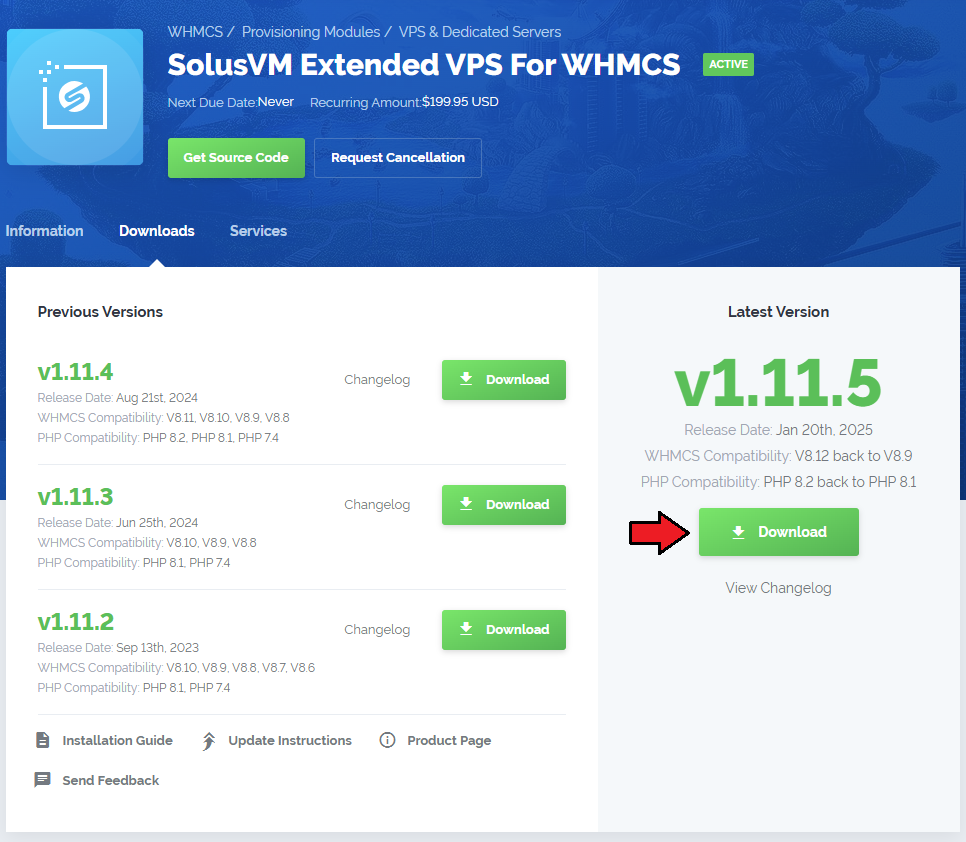
|
| 2. Upload and extract the module into the main WHMCS directory. Files in your WHMCS directory should look like this. |

|
| 3. When you install SolusVM Extended VPS for the first time you have to rename 'license_RENAME.php' file. File is located in 'modules/servers/solusvmExtendedVPS/license_RENAME.php' . Rename it from 'license_RENAME.php' to 'license.php' . |
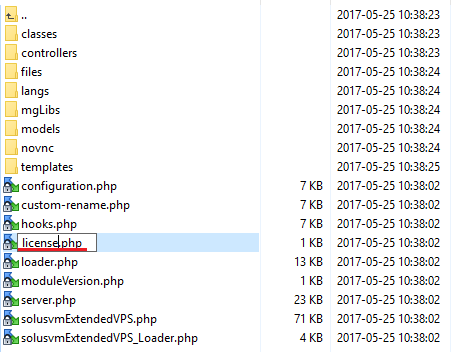
|
| 4. In order to configure your license key, you have to edit a previously renamed 'license.php' file. Enter your license key between quotation marks as presented on the following screen. You can find your license key in your client area → 'My Products' . |

|
Configuration of API Access
| 5. Now, we will show you how to configure a new product. Firstly, log in to your SolusVM admin area, go to 'Configuration' → 'API Access' and press 'Add API User' . |

|
| 6. Fill in your IP address and once again click on 'Add API User' button. |

|
Configuration of Server
| 7. Now, log in to your WHMCS admin area and proceed to 'Setup' → 'Products/Services' → 'Servers' . Afterwards, press 'Add New Server' . |
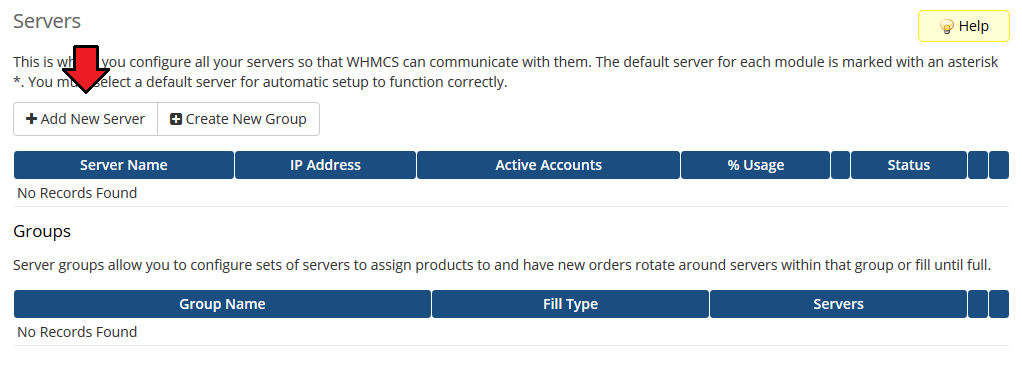
|
8. Enter your server name and IP address.
Choose 'SolusvmExtendedVPS' from a dropdown menu and press 'Save Changes' . |
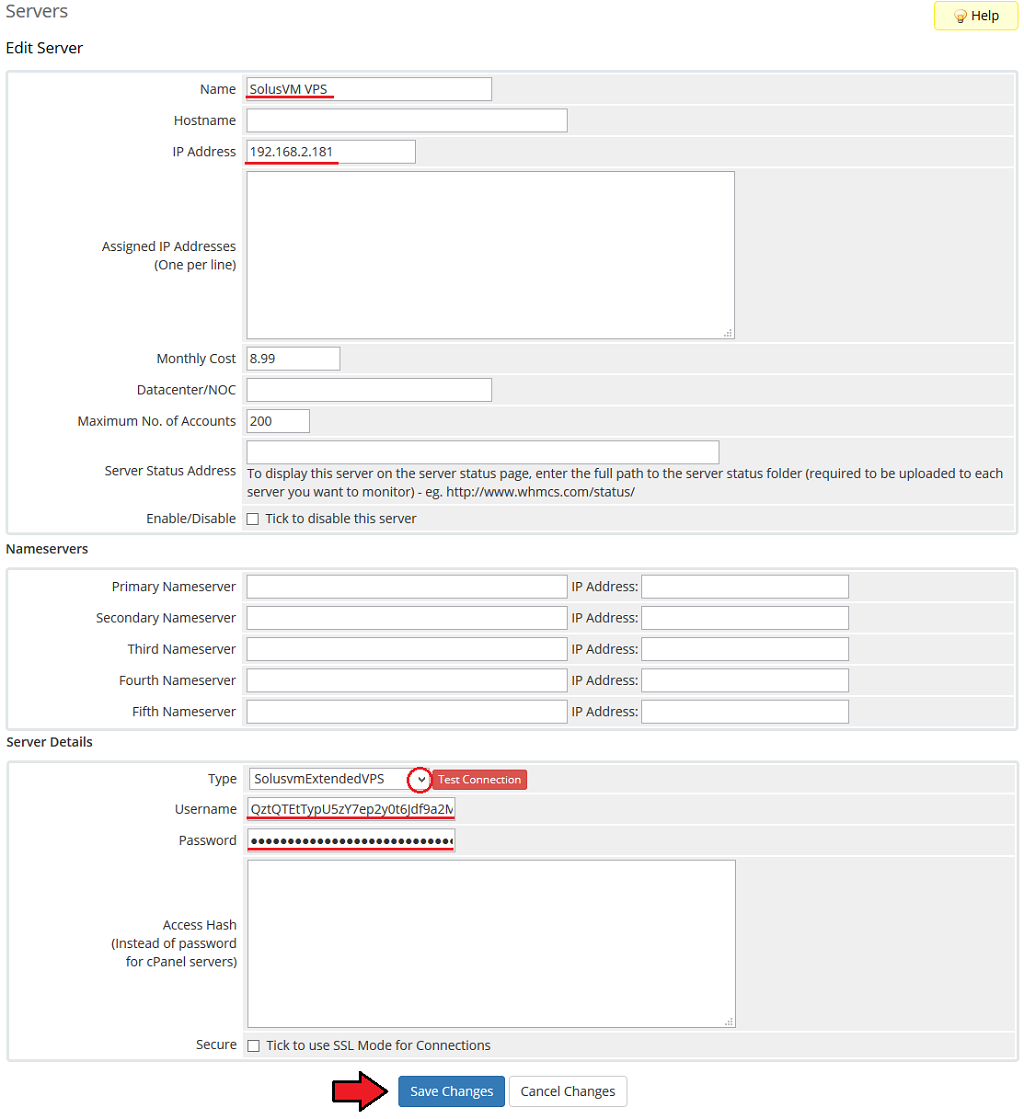
|
| 9. After configuring your server correctly, you are going to see a following screen. Test your connection and API key through pressing 'Test Connection' . |
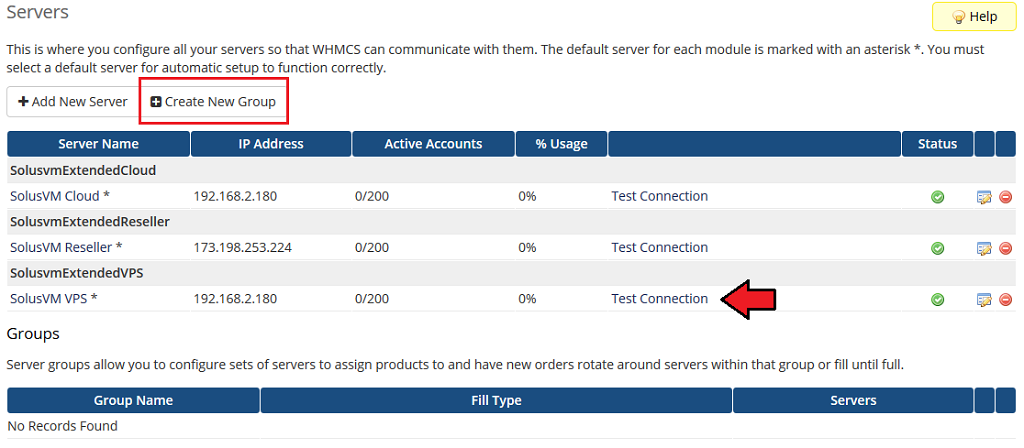
|
| 10. Fill in name, choose a previously created server and press 'Add' . Confirm through clicking on 'Save Changes' . |
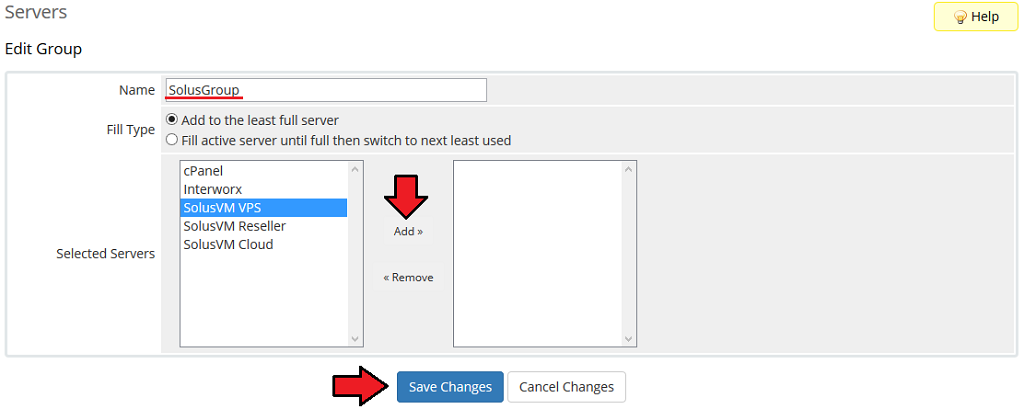
|
Configuration of Product
| 11. In order to create and configure product, go to 'Setup' → 'Products/Services' → 'Products/Services' . Afterwards, click on 'Create a New Group' . |

|
| 12. Fill in a product group name and press 'Save Changes' . |
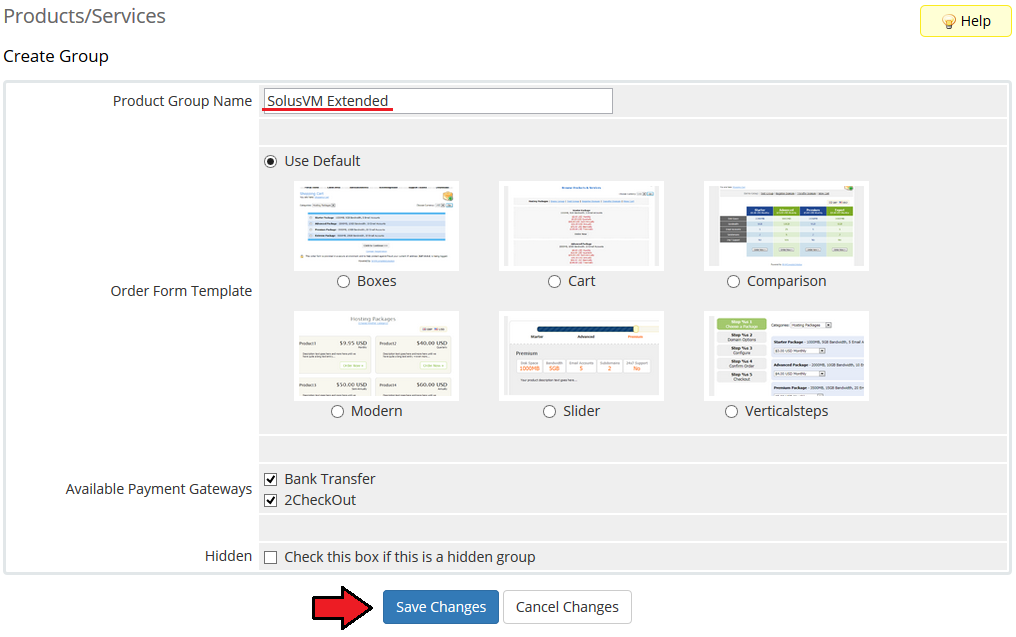
|
| 13. When you have a product group, you can create your product and assign it to SolusVM Extended VPS. To create a product click on 'Create a New Product' . |

|
| 14. Afterwards, choose your product type and product group from dropdown menus, fill in your product name and press 'Continue' . |

|
| 15. Now, go to 'Module Settings' section, choose both 'SolusvmExtendedVPS' and a previously created server group from dropdown menus. Afterwards, press 'Save Changes' . |
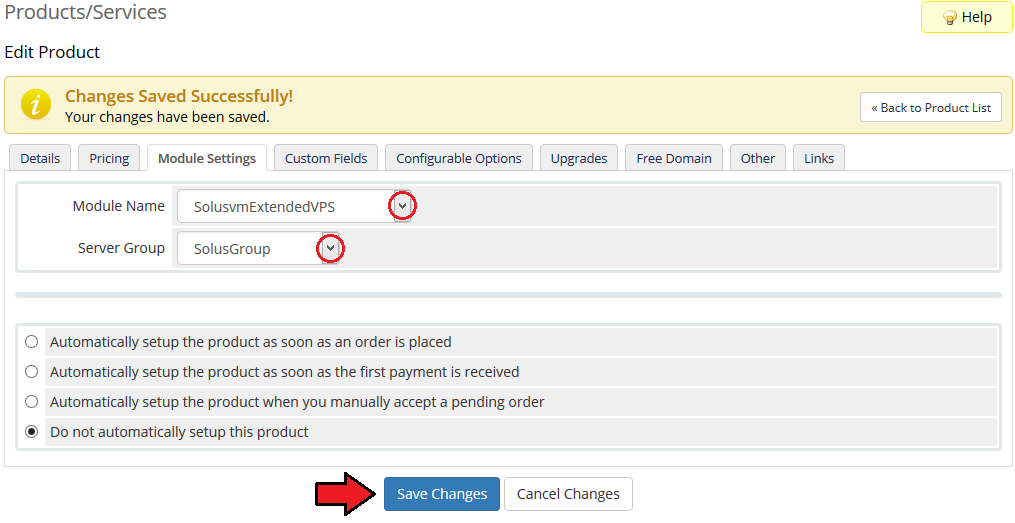
|
| 16. Start configuration of a product with 'Product Configuration' section. Select desired 'Virtualization Type' and press 'Save Changes' in order to load the virtualization. |
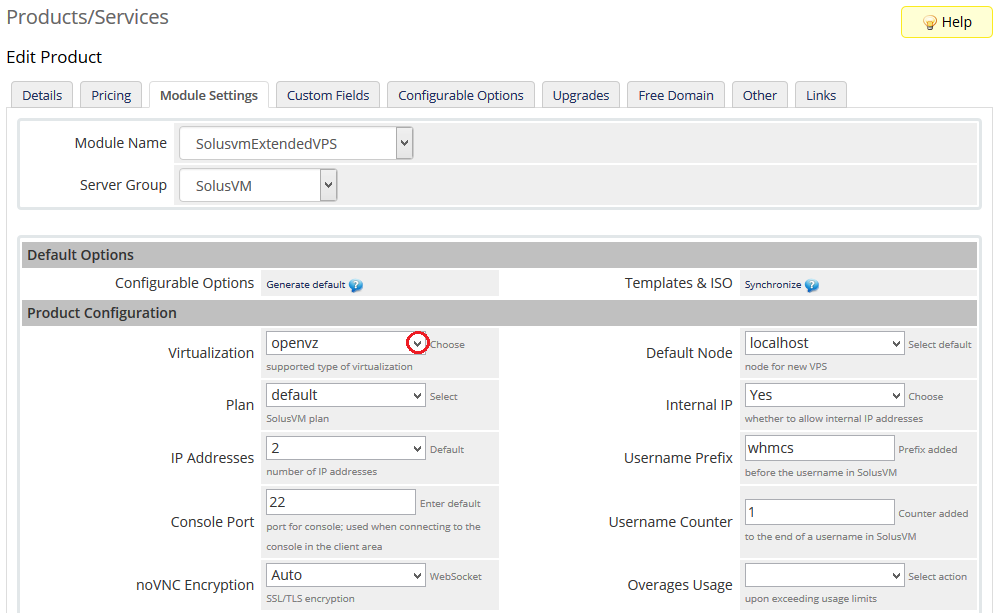
|
| 17. Now, choose 'Default Node' , 'Plan' , 'Default Operating System' , 'Number of IPs' and 'Default Node Group' . |
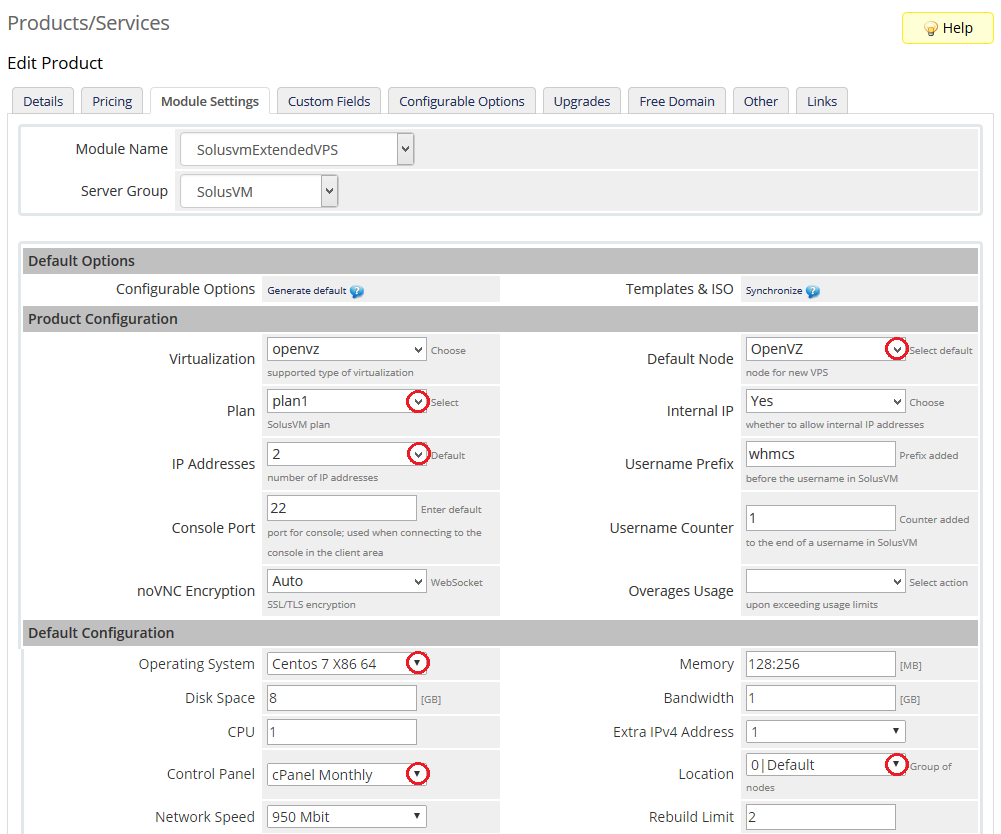
|
| 18. Define features available in the client area through marking/unmarking them under 'Client Area Features' section. Important: Keep in mind that the root password is generated automatically for KVM virtualization upon its creation and reset. |
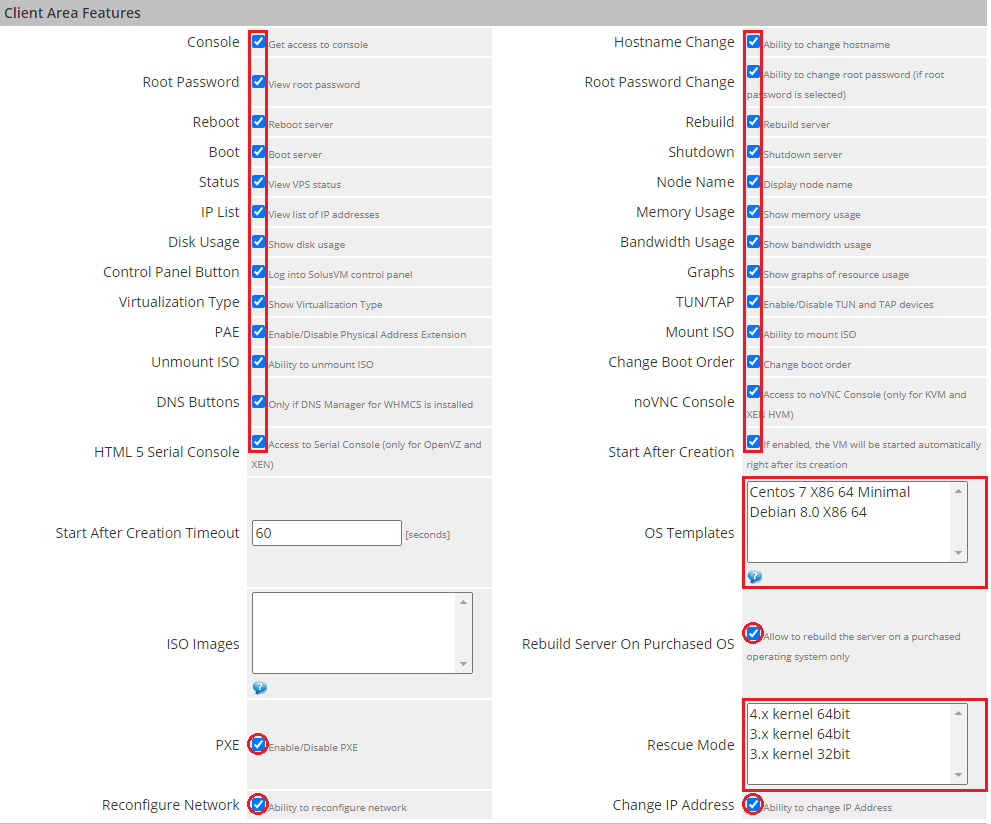
|
| 20. The final step is generating default configurable options. To do so, press 'Generate Default' near 'Configurable Options' as shown on the screen below. |
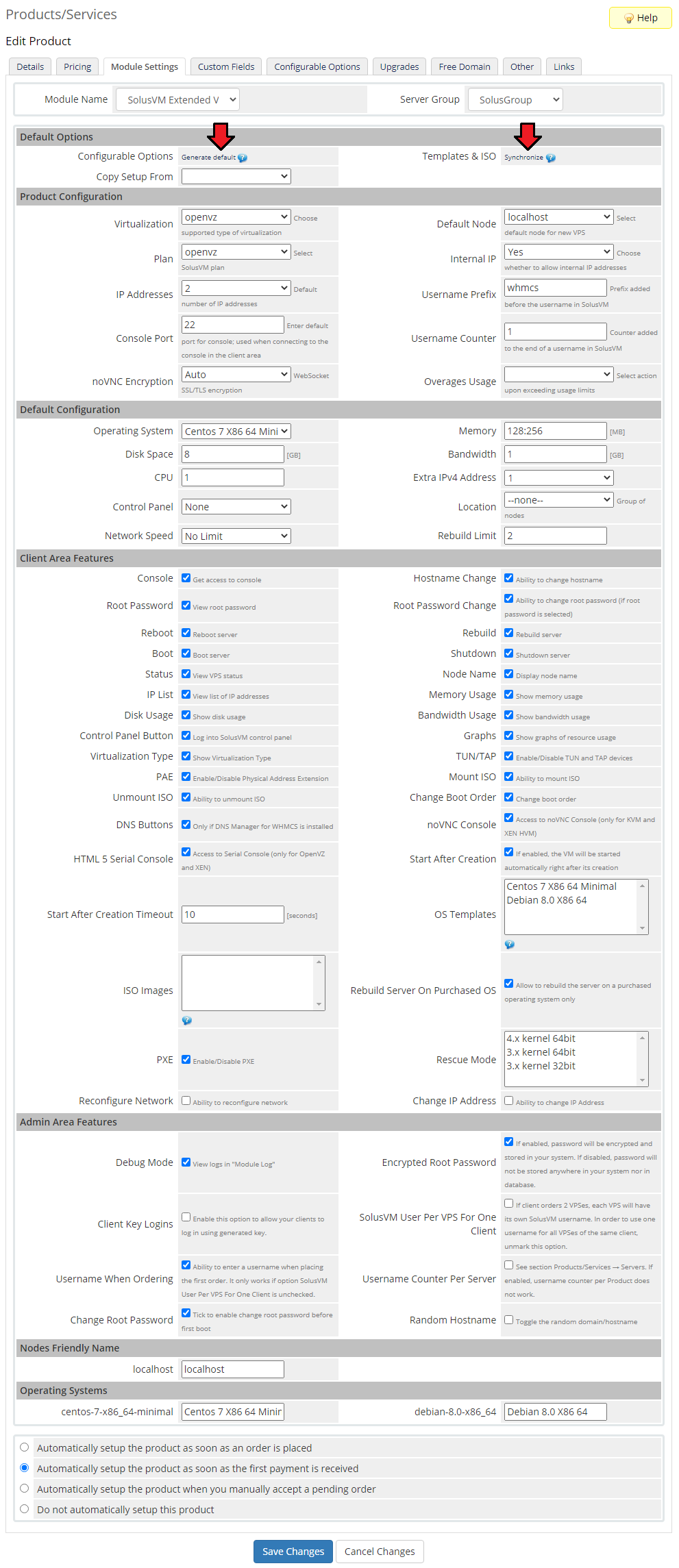
|
| You have just finished the installation and configuration of the module! |
Management
| SolusVM Extended VPS For WHMCS offers very intuitive management of virtual servers both for your admins and clients. In addition to that, it provides you with the ability to offer your clients VPS tailored to their needs. |
Interface
| Now let's check the interface of the module in your WHMCS client area. As you can see, everything your customers need is in one place. Note: List of available features depends on the selected virtualization. |
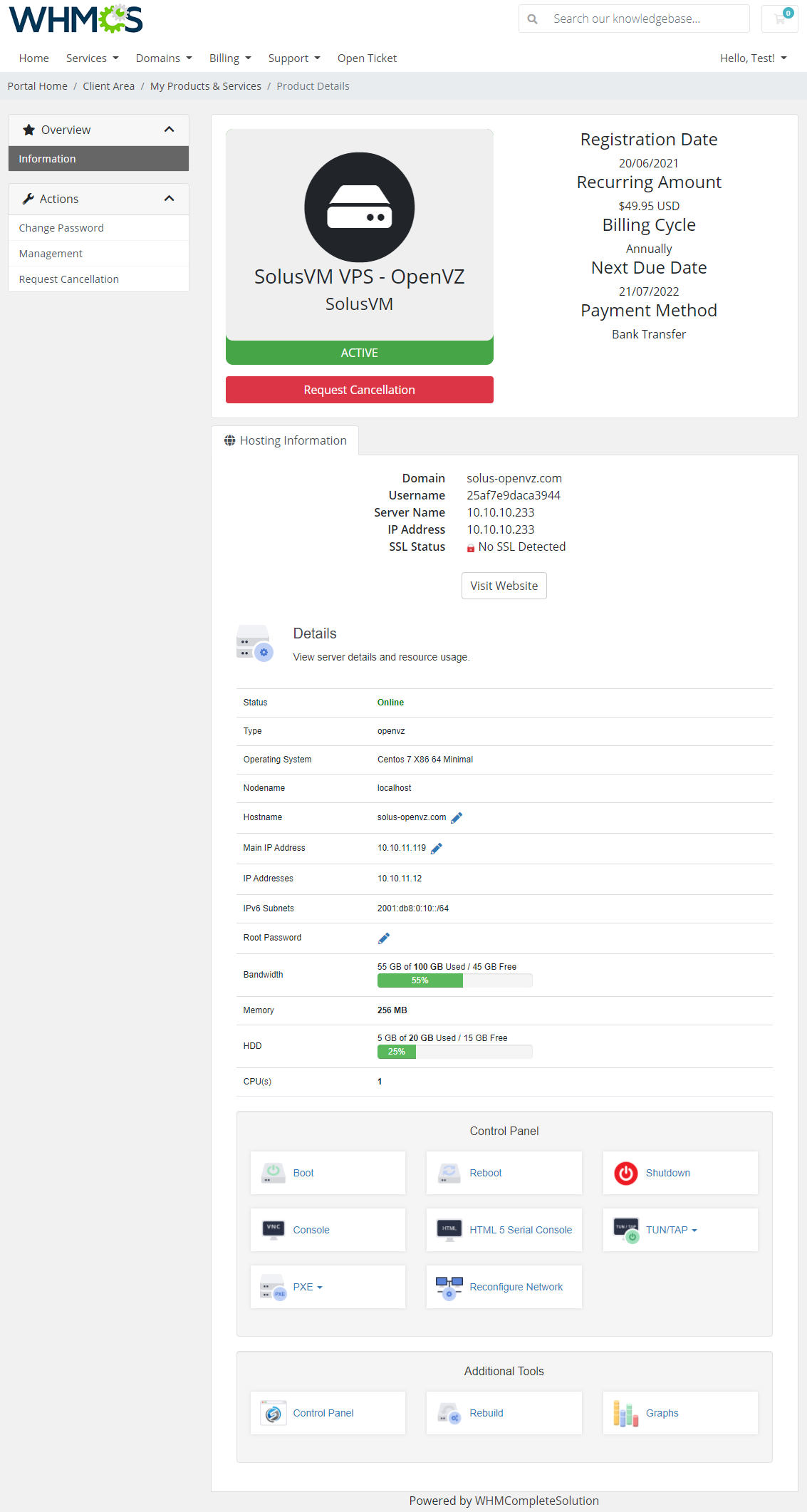
|
| The above screen presents 'Classic Design' introduced in version 1.2. You can switch between designs by ticking 'Classic Design' in the product 'Module Settings' → 'Client Area Features' . |
| File:SV19.png |
| You can monitor and manage each product from your WHMCS admin area. |
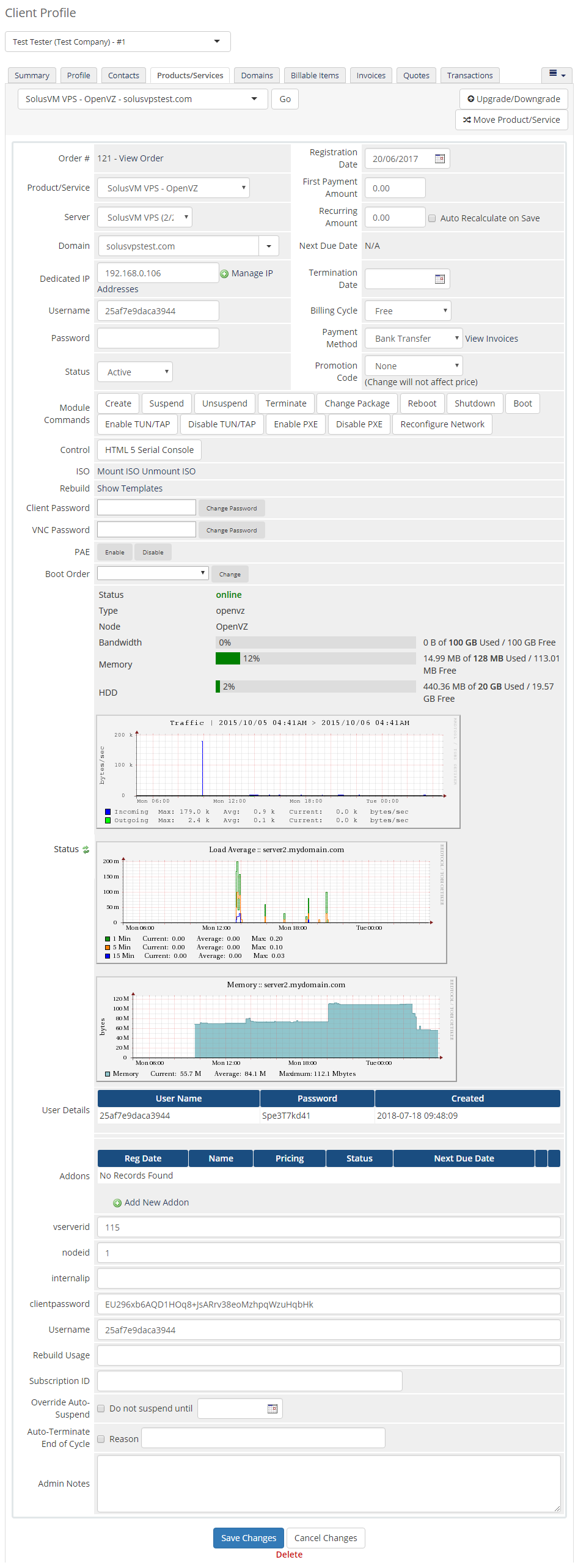
|
Management of Server
| Module allows your customers to easily log into control panel (1), access SSH/VNC console (2), boot, reboot (3), shutdown (4), rebuild (5) and delete (6) their VPSes. In an addition to that, your clients can change hostname (7) and root password (8), set up boot order (9). |
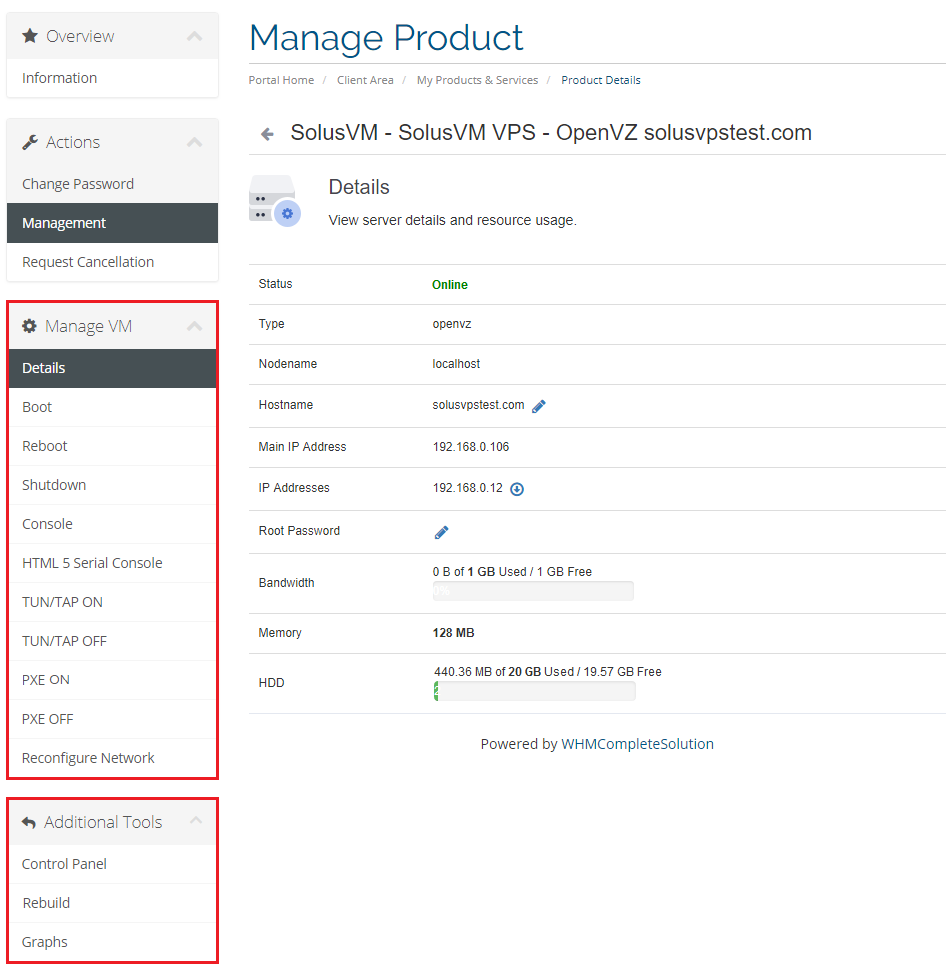
|
| One of the most interesting functionalities is SSH console, where your clients can remotely manage server. To access it, simply press 'Console' button. Note: This type of console is available only for OpenVZ & Xen virtualization. |
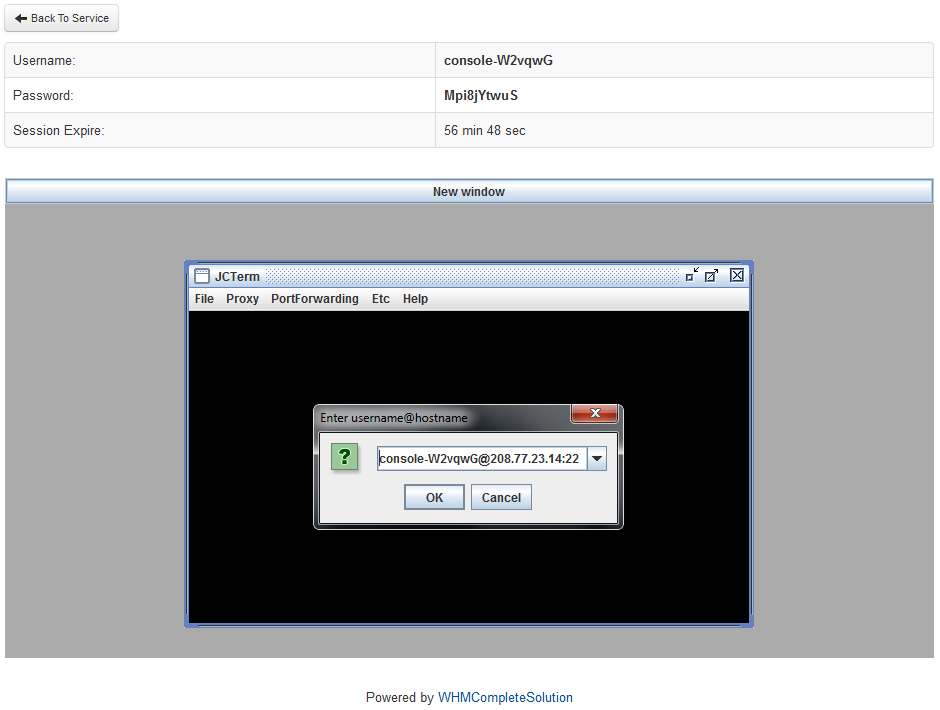
|
| The module also enables remote access to VNC console. Note: VNC console is used by KVM and Xen HVM virtualization. |
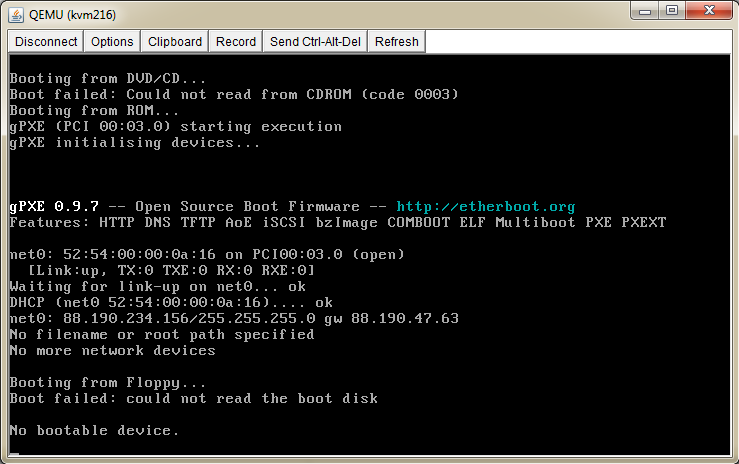
|
| Rebuild feature allows you to change OS template from available OS templates list. To rebuild your server click on 'Rebuild' button, choose template and confirm through pressing 'Rebuild' button. |
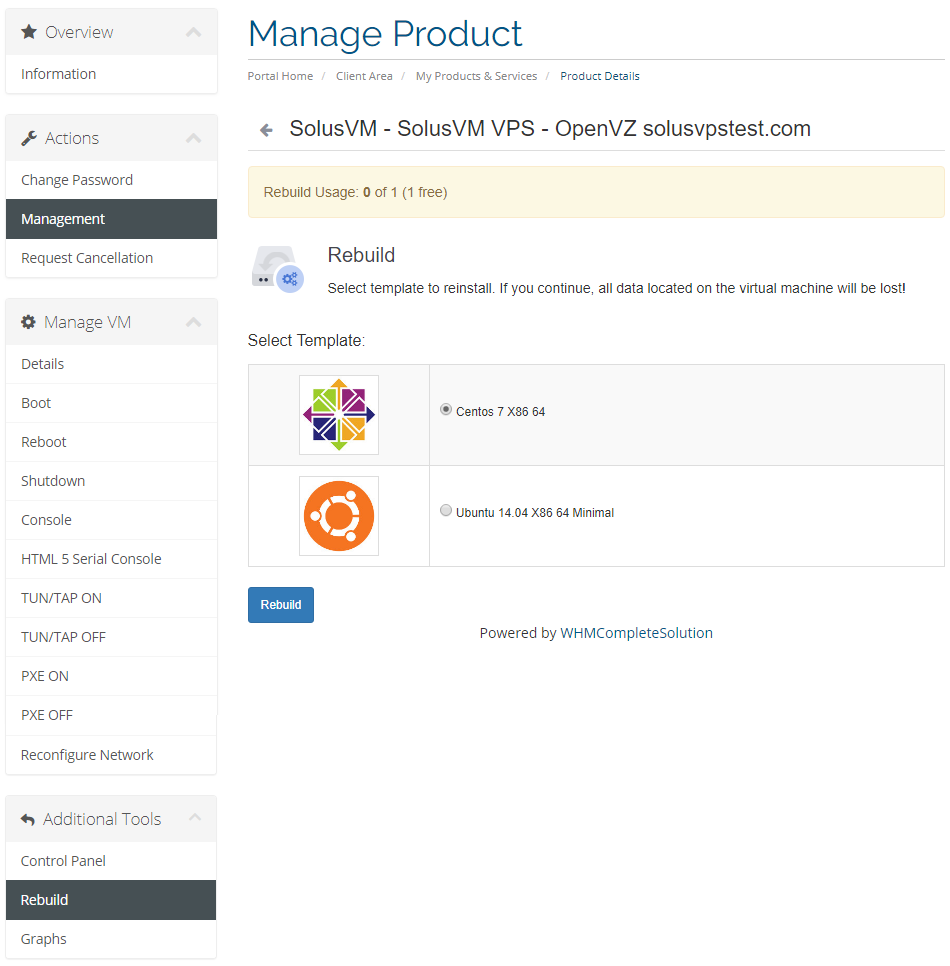
|
Management of Email Templates
| You can automatically send your customers emails with details of newly created virtual servers. To do so, create a new email template with 'Product' type and 'Unique Name' specified in SolusVM Documentation, in our case it is 'KVM Virtual Server' . |

|
You can paste the email content from SolusVM Documentation or create your own. Owing to our module, you can also use variables:
|
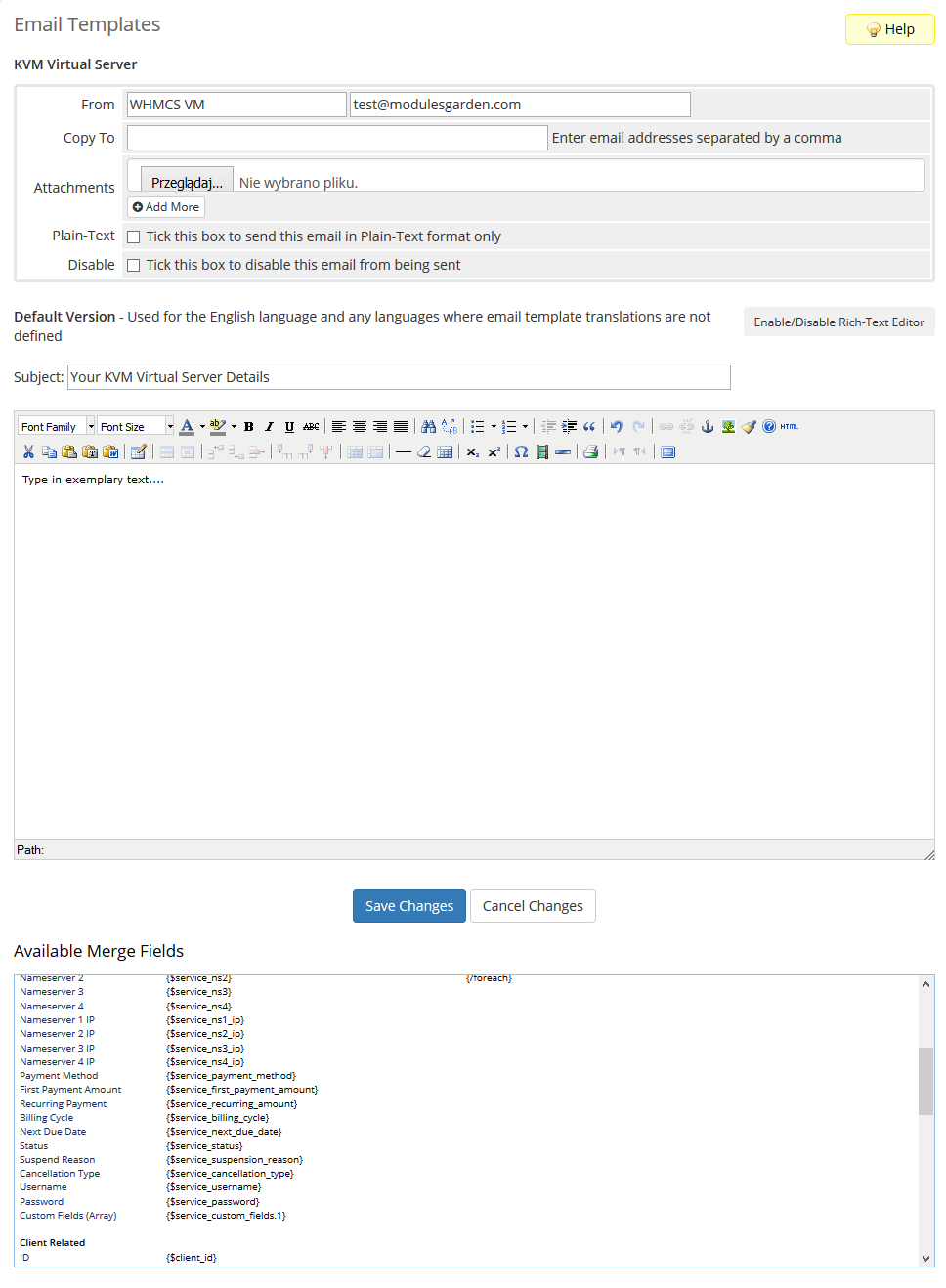
|
Management of Custom Hooks
| Our module allows you to use custom hooks.All you need is knowledge of PHP programming language. Possible hooks are:
To enable these hooks, you have to rename file 'custom-rename.php' to 'custom.php' . |

|
| Now your hooks are active, but since they are empty they do nothing. To find hooks' details, read a previously edited file. In the mentioned file you are going to find the hook, information about its time of run, returned values and parameters. |

|
Dynamic Server Resources Setup With Configurable Options
| If you wish to allow your clients to order servers with resources they choose, use configurable option group. To generate a configurable option group for a product, head to 19th step of 'Configuration of Product' instruction. |
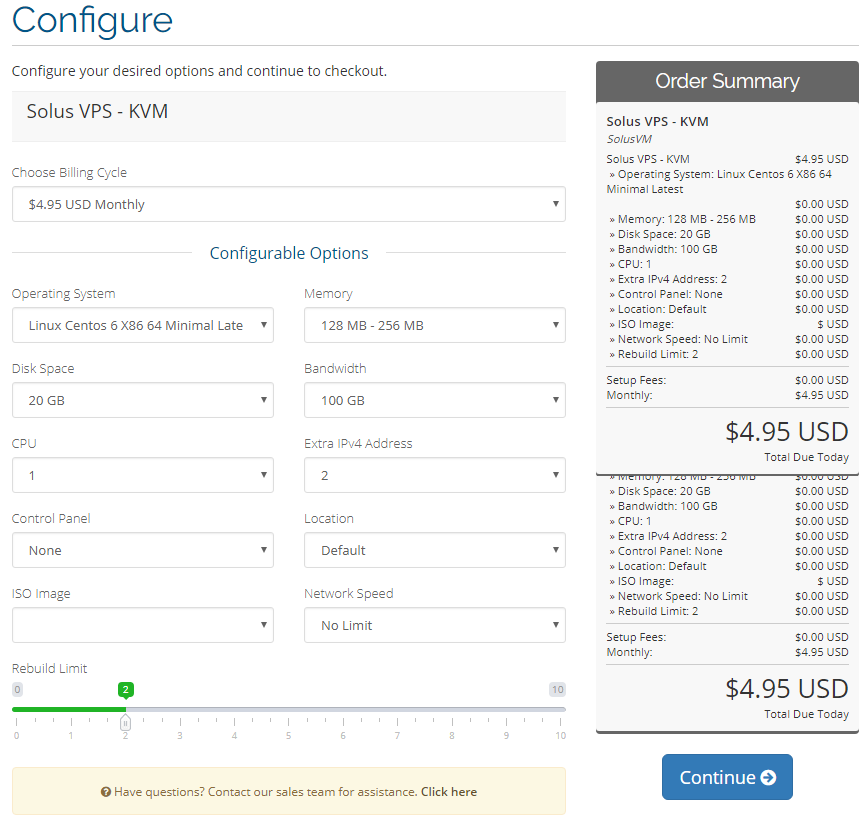
|
| If automatically generated configurable options do not fulfil your clients' needs, you can edit them using this guide. |
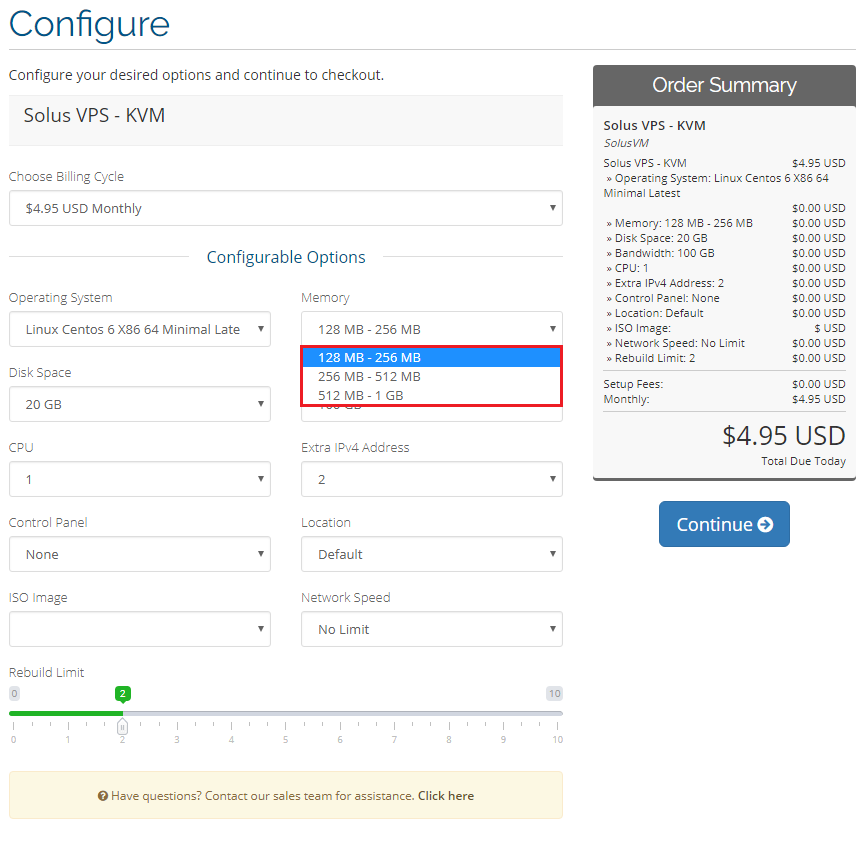
|
| If you decide to set up pricing depending on the ordered resource, you can find instruction on how to proceed here. |
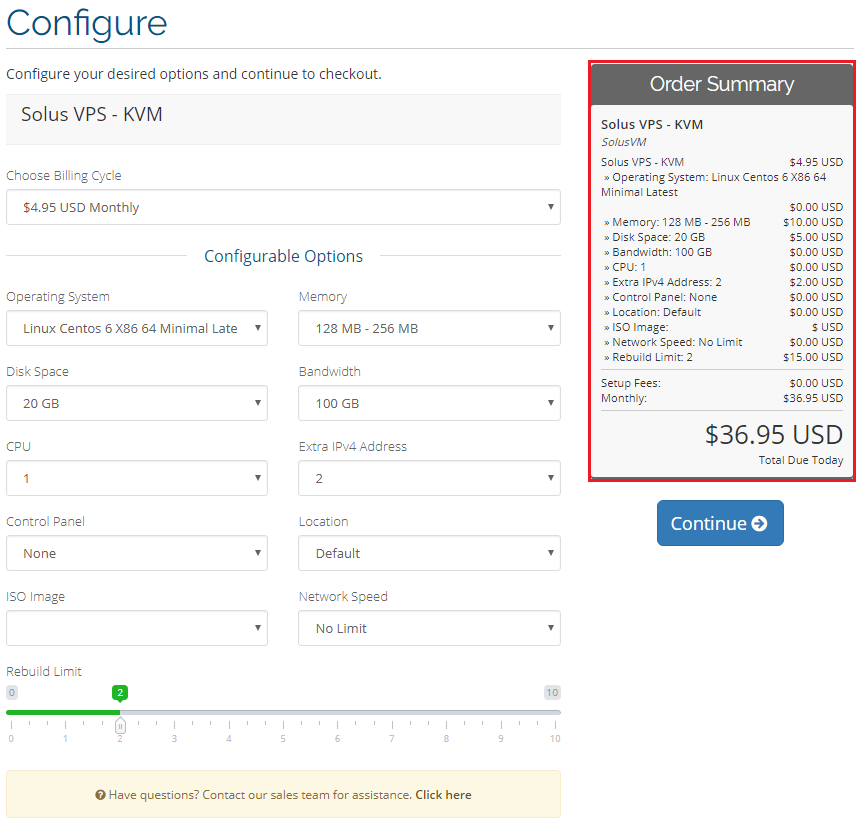
|
| If you prefer to charge your clients for server resources they actually use, you can use our Advanced Billing For WHMCS module. |
Management of DNS
| When you combine SolusVM Extended VPS For WHMCS with DNS Manager For WHMCS, your clients will be able to manage PowerDNS zones and records from the client area. DNS Manager For WHMCS will allow your customers to manage DNS zones, records and ReverseDNS. |
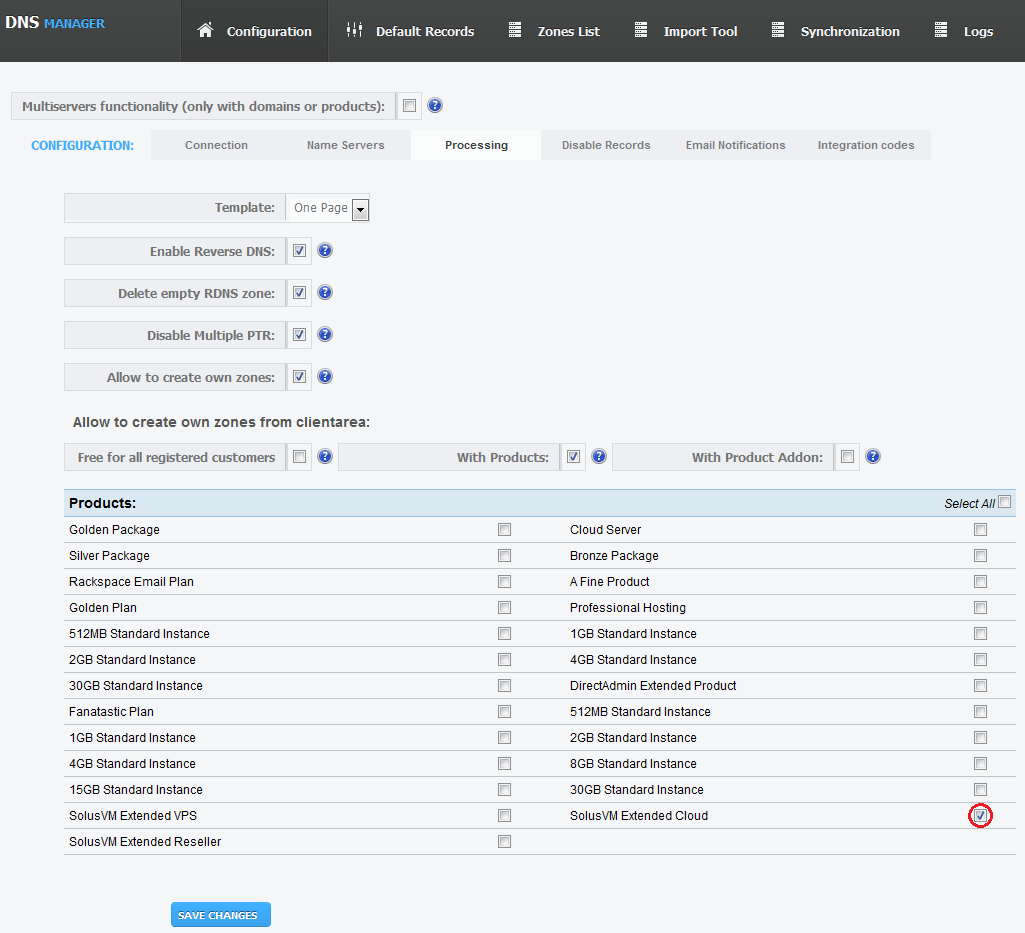
|
| Afterwards, buttons 'Manage DNS' and 'Manage Reverse DNS' will appear in the client area as shown on the screen below. |
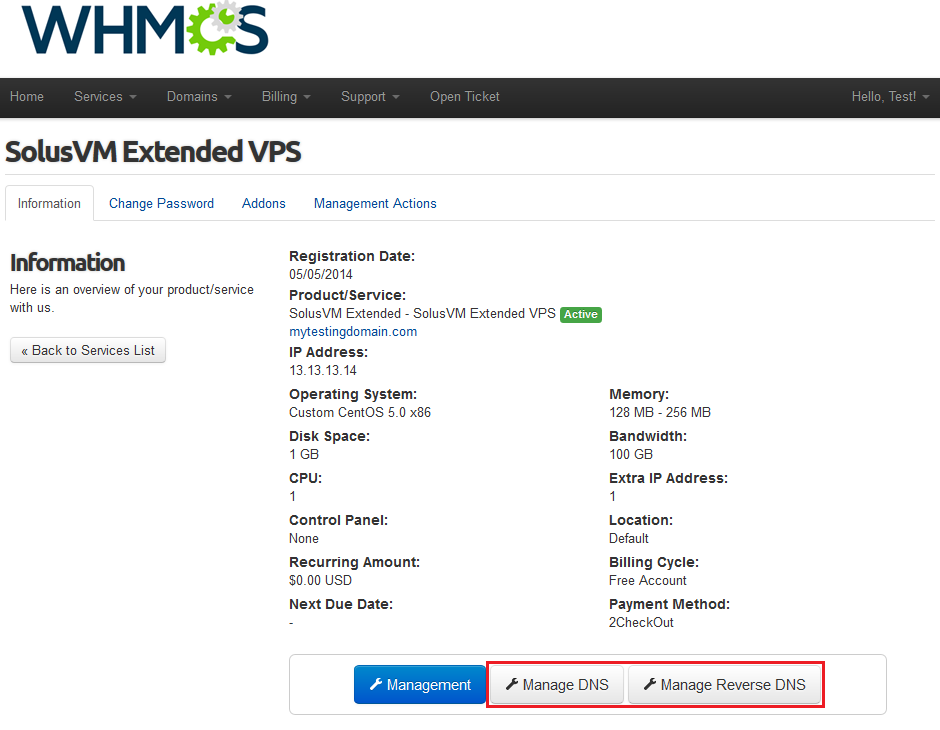
|
| Depending on your previously chosen settings, your customers will be able to add, edit and remove DNS zones and records. |
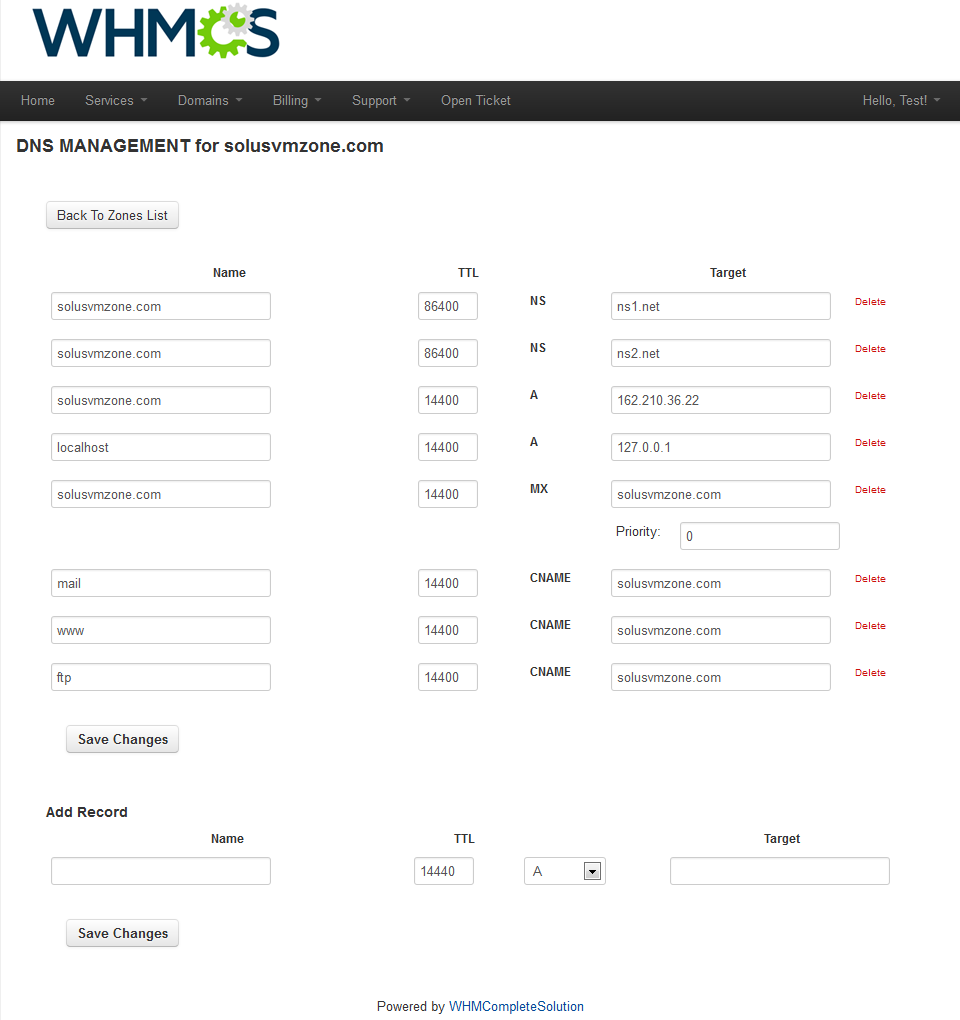
|
| The module will also allow your customers to add, edit and remove Reverse DNS zones and records. |
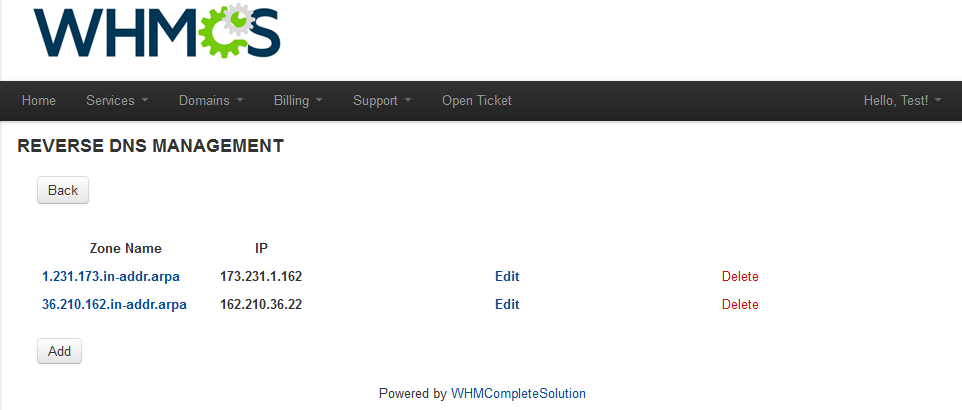
|
Management of Billing
| When you combine SolusVM Extended VPS For WHMCS with Advanced Billing For WHMCS, you will be able to set up additional billing options. The module allows you to charge your customers basing on the server resources used by them. |
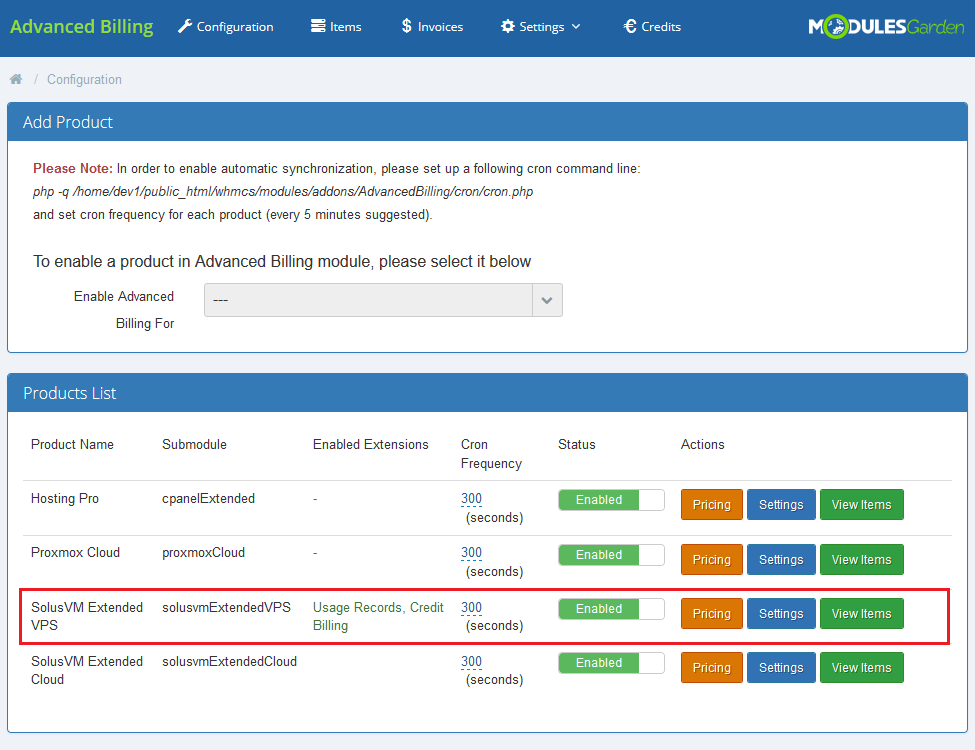
|
| With Advanced Billing module, you can also display the current server resource usage and their cost for your customers. |
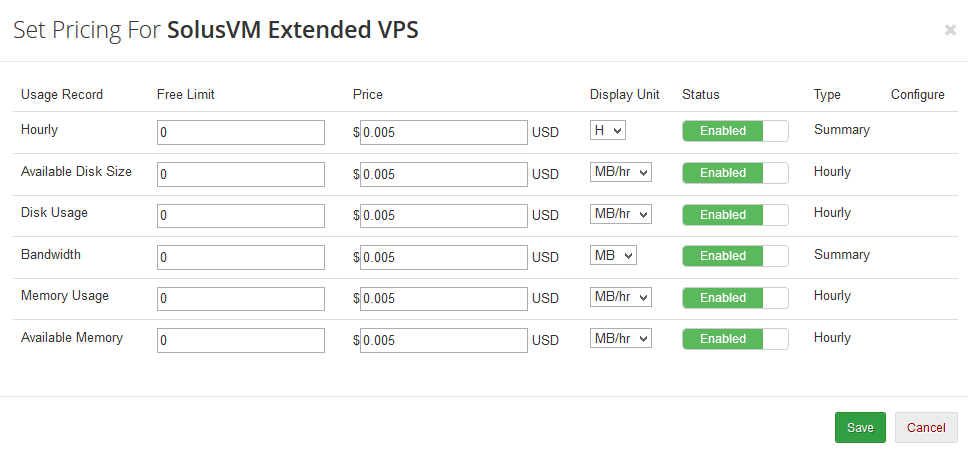
|
Update of Products
| Our module is entirely compatible with SolusVM Pro module and you can easily upgrade your existing products without losing your settings. 1. Go to 'Setup' → 'Products/Services' → 'Products/Services' → 'Module Settings' of your product and switch 'Module Name' from 'Solusvmpro' to 'SolusvmExtendedVPS' . |
Debug Mode
| SolusVM Extended VPS is a very complex module. Therefore many things might go wrong. To help you quickly solve various problems usually connected with WHMCS product/server configuration and SolusVM server configuration, we created 'Debug Mode' . |
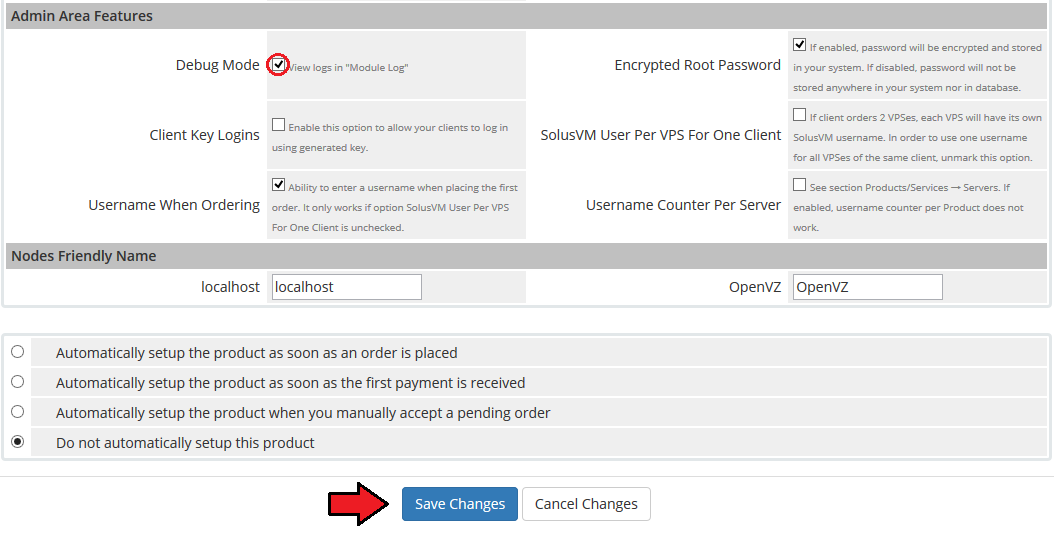
|
| Afterwards, go to 'Utilities' → 'Logs' → 'Module Log' and click on 'Enable Debug Logging' in order to enable it. Now, each action performed by the module will be recorded in the module log. |
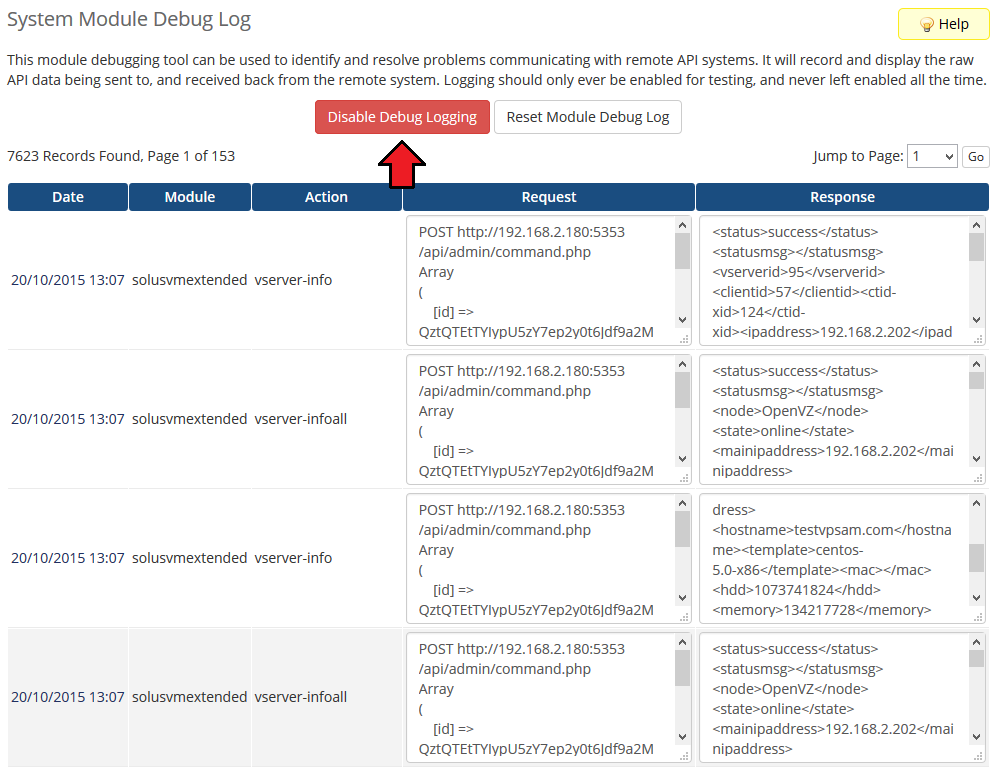
|
| Remember to turn off Debug Mode after you fix the problem. |
Tips
| 1. We made every effort to make our module as easy to install, configure and use, as possible. Therefore we paid special attention to displayed messages. Read carefully each message, follow the instructions and you shall have no problems with using the module. |
| 2. Operations performed on the virtual servers are not executed immediately. Give your SolusVM server some time to processing the request and execution of operation. |
| 3. In the current version of SolusVM API there is no possibility to automatically upgrade Virtual Machine therefore you have to perform this action manually. Upgrading package in the SolusVM VPS Extended module means upgrading Solus Plan. |
Common Problems
| 1. When you have problems with connection, check whether your SELinux or firewall does not block ports. |
| 2. The vast majority of problems are connected with misconfigured SolusVM server or misconfigured servers/products in your WHMCS. Firstly, make sure that your SolusVM server has properly configured virtual servers, nodes, node groups, templates, plans and API access. |
| 3. Your client gets white page with '{"success":"1","status":"1"}' while entering 'Control Panel' . Cause: SolusVM client area template is based on Bootstrap, which may sometimes cause such errors. |
4. You have received following error:
Error 'Fatal error: Call to undefined function mime_content_type() in /your_whmcs/clients/modules/servers/solusvmExtendedVPS/solusvmExtendedVPS.php on line 0 '. Reason: Function 'mime_content_type()' is disabled at your server. Our module uses it in order to detect MIME Content-type for a file. |
| 5. By default our module connects with SolusVM server on port 5353. If you are using different port, you need to specify it in 'Hostname' field. Default port for SSL connections is 5656. To connect on that port enter your hostname as follows: 'yourhostname.com:5656' . Keep in mind that you can connect on any port. |